
Please send all Checks and Money orders to :
Dave Taylor P.O. Box 87 Sylvania, OH 43560
419-842-1863
Click Here to E-mail Us!


15 08
LAYAWAYS ARE WELCOME:
Need to split your order into multiple payments? No problem! A simple 20% earnest money deposit will hold your item for you.
You can then pay it off in easy installments that fit your budget.
Read Terms Here
~~~~~~~~~~

15-08-01 … John Blanch & Son Cased Large Adams Revolver and Accoutrements …
Superb Cased Adams Revolver A top shelf cased Adams army revolver with great eye appeal and flash. In Britain the Adams revolver was a big competitor to Colt and in America the Adams revolvers have a strong association with the Confederacy. The south imported a bunch of them, and I have one in my collection in the original rebel holster on a Richmond CS sword belt with CS buckle. Many were carried by prominent Confederate officers. Ours is a superb high finish example, elegantly cased by John Blanch and Son of Gracechurch Street in London. Included in the casing is its cleaning rod, brass bullet mold, nipple wrench, powder flask and a couple of loose bullets. The flask is a magnificent period example but was not originally part of this casing. The previous owner added it to the empty flask compartment because the patina was PERFECT. The oak box preserves its original green lining and Blanch and Son paper label. All compartment dividers are present. The pistol exhibits excellent checkered wood grips and a beautiful, lustrous British blue on better than 90 percent of the barrel and frame. The hammer and sections of the loading lever assembly show bright. Crown view and proof marks are present as is the company name and address on the top strap of the pistol and the Adams patent and serial number on the lower frame and cylinder. Adding to the eye appeal is some very delicate floral engraving on the rear of the frame behind and below the cylinder. The powder flask is a high art two-compartment flask with raised floral scroll motifs and the thumbspring and spout in place. The nipple wrench has the typical flat-sided oval grip with brass ferrule and silver colored neck with square hole for the nipples. The brass mold has a serial number “12” on it, and a “54” next to an oval patent stamp and retains nice color on the sprue cutter. English 54 bore equates to US .45 caliber. Cased sets have a strong across-the-board appeal and these large frame British revolvers are especially impressive. A very fine example of this revolver in a very classy casing, perfect to display with a Confederate officer’s effects … noco
… $4,450.00
Click Here to E-mail Us!
Call us @ 419-842-1863
~~~~~~~~~~~~~~~~~~~~~~~~~~~~~~~~~~~~~~~~~~~~~~~~~~~~~~~~~~~~~~~~~~~~~~
NOTE: In case you did not know this trick….
To enlarge the photos hold down the control key and press the + (plus) key a couple times. To return to the standard size hold down the control key and press the – (minus) key a couple times.
~~~~~~~~~~~~~~~~~~~~~~~~~~~~~~~~~~~~~~~~~~~~~~~~~~~~~~~~~~~~~~~~~~~~~~

15-08-02 … 1860 dated m1855 Springfield Rifle Musket …
One of the most sought-after of all Civil War longarms are these 1855 patchbox rifle muskets … and this one is a dandy. The 1855 series of arms introduced numerous innovations to American martial arms. The 1855 rifle musket was the first of the rifles of musket length firing the .58 Caliber Minie ball. They were designed for regular infantry of the line and made use of Dr. Maynard’s ill-conceived tape primer system. Springfield produced some 47,000 of them. They were one of the principal longarms of the war and the basis for the 1861 rifle muskets as well as the Confederate Richmond rifle muskets. Ours has very clear US Springfield lock markings with an 1860 date, a clear Springfield eagle on the primer door, and crisp V/P/eagle barrel proofs. The barrel has faintly visible matching “1860” date and the full view and proof stamps on the breech. Has the correct early pattern rear sight (rear step on the base and linear profile) with both leaves, and of course the steel patchbox introduced in 1859 is inlet into the butt stock. The Swivels, bands, springs and rod all in place and original. The gun is 100% original, 100% complete, and mechanically perfect. Small initials JC carved in the offside opposite the lock, and a J next to the trigger guard on either side. A small rack number “14” stamped on the top wrist. Metal is bright overall with scattered dark gray spots. Wood is very good with faint cartouches visible, and only slight rounding to the edges. A darn nice example of a classic, and very scarce Civil War infantry weapon. These patchbox 55s were scarce when I was a kid. … bejj
… $3,650.00 – SOLD
Click Here to E-mail Us!
Call us @ 419-842-1863

15-08-03 … 1857 Ames Heavy Cavalry Saber! …
One of the scarcer US sabers to find are these strong condition Ames heavy cavalry sabers. Used from the Mexican War right into the Civil War, most show heavy use and age. This saber is much finer condition than most. Grip leather and twisted wire wrap are outstanding and original. Blade is deeply marked with full Ames firm name and address, inspector’s marks, and manufacture date of 1857. Nice untouched patina to the brass hilt. Blade showing bright with a darker gray midsection on either side. Very clear 1850s style Ames blade stamp on the ricasso, along with the US, “JH” inspector’s initials, and 1857 date on the other side. Scabbard is solid showing mostly steel gray patina mixed with some aged brown. The light cavalry sabers began production this same year making this “heavy” specimen an end of production piece. I don’t recall what the last year of production is on the “heavies” but I believe it was 1857 or 1858. A key US edged weapon for sword, cavalry and Civil War collectors … ejj-mil
… $950.00 – SOLD
Click Here to E-mail Us!
Call us @ 419-842-1863

15-08-04 … 1862 Dated Ames 1840 Light Artillery Saber …
Classic Civil War field artilleryman’s saber. The light artillery saber of 1840, like the heavy cavalry saber, followed French patterns of the day. The idea was that artillerymen in the horse artillery units and artillery drivers might have to defend themselves while mounted and therefor needed a sword. (A revolver might have been a better idea, but the army had its own way of doing things.) This is the Type-2 style using a conventional scabbard throat and pad under the guard rather than the Type-1 where the scabbard mouth slips into a recessed oval on the underside of the guard. As is often the case, the Ames logo on the ricasso is weak, but the US/ J.H./1862 stamp on the other side is strong and legible. Leather wrap and wire are original and truly outstanding condition. Blade shows bright overall. Scabbard is a dull silver gray, no pitting. Rings, drag and throat all in place. A top drawer example of a great Civil War saber … ge-mil
… $895.00
– SOLD
Click Here to E-mail Us!
Call us @ 419-842-1863
~~~~~~~~~~~~~~~~~~~~~~~~~~~~~~~~~~~~~~~~~~~~~~~~~~~~~~~~~~~~~~~~~~~~~~
NOTE: In case you did not know this trick….
To enlarge the photos hold down the control key and press the + (plus) key a couple times. To return to the standard size hold down the control key and press the – (minus) key a couple times.
~~~~~~~~~~~~~~~~~~~~~~~~~~~~~~~~~~~~~~~~~~~~~~~~~~~~~~~~~~~~~~~~~~~~~~

15-08-05 … Spectacular Cadet Model 1844 Piedmontese Musket …
This is only the second one of these I have owned. I sold the last one a couple years ago, and was happy to find another. An exact miniature of the full size musket still in .69 caliber. Barrel is 30 inches. Overall length is 43 inches. Perfect size for an eight or ten year old boy. It is based on the French 1822 musket and adopted in the Italian Kingdom of Piedmont in 1844 (also called Piedmont-Sardinia as the Kingdom of Sardinia absorbed and unified the various smaller Italian states.) The full size weapons were produced at the state arsenal at Torino and on contract in Belgium. A number of the Belgian produced guns made their way over here as part of the early war effort to supplement our own arms production. Ours is a cadet version made at Torino and dated 1864 on the lock and 1863 on the right breech. Clear lock plate markings, numerous assembly numbers on the various parts and proofs on the barrel. Iron mounted overall. All bands, springs, ramrod, and swivels in place. Metal is attractive light brown patina with some darker spots, smooth overall. Wood is very pleasing with a couple of dings and some dark areas along the butt plate. The circular government ink stamp is still visible on the butt stock. I have always been fascinated by boys muskets, cadet muskets, etc. … Likely a throwback to what I would have wanted in my childhood. I never pass up the opportunity to buy one of these Lilliputian rarities when I find one priced honestly. Here is a superb example. Totally charming. Incredibly rare yet affordable …eej
… $850.00 – SOLD
Click Here to E-mail Us!
Call us @ 419-842-1863
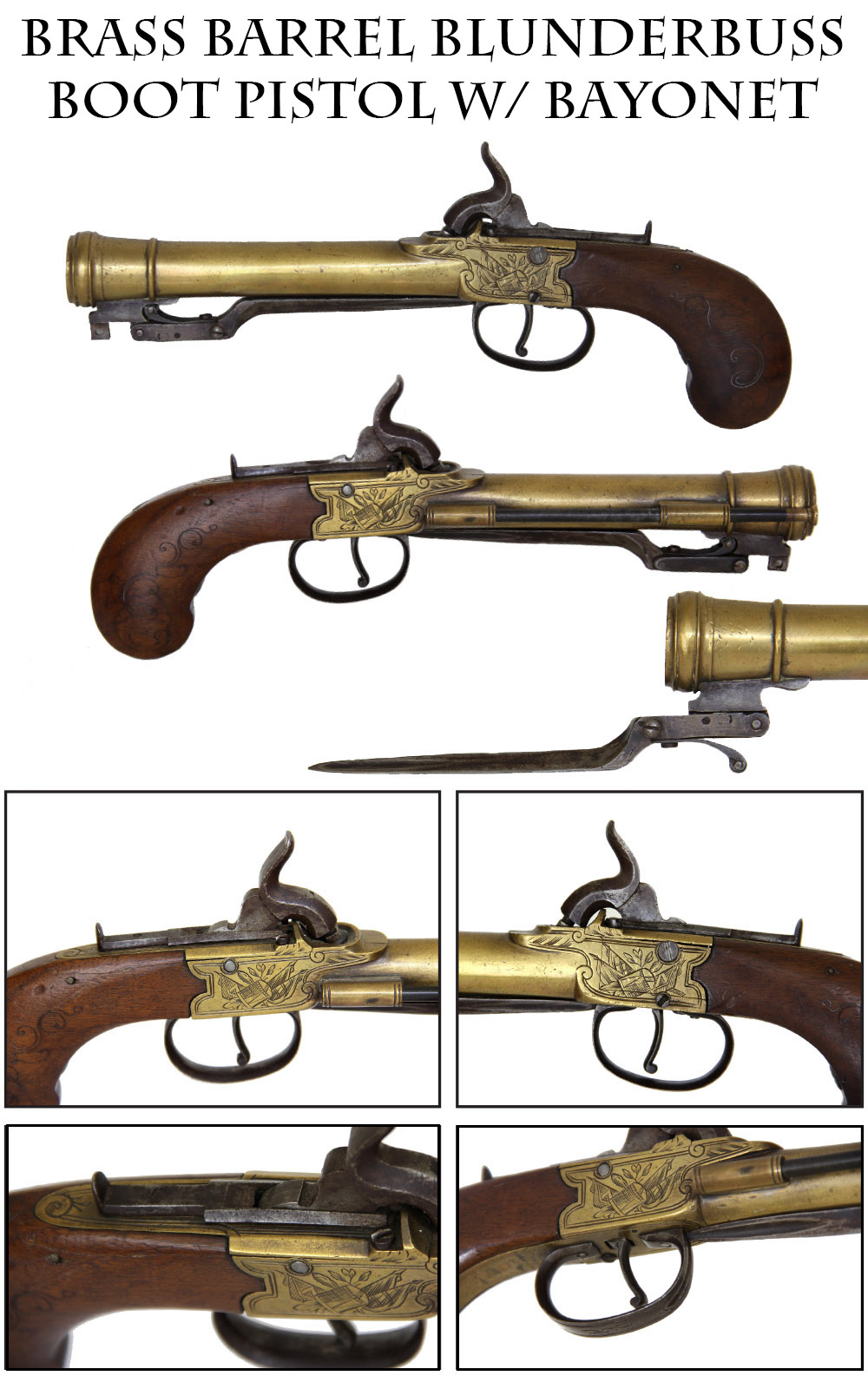
15-08-06 … Brass Barrel Blunderbuss Pistol with Folding Bayonet …
Wonderfully eye catching old time English man killer circa 1840. Percussion blunderbuss pistol with a pronounced flared muzzle cannon barrel and a folding bayonet on the underside. Measures 11 inches overall length with a 6 inch brass barrel. A very attractive pistol meant for some nasty business, modeled on 18th and early 19th century privately purchased naval pistols meant for close combat in boarding actions on ships. Bag-shaped English walnut grip is inlaid with thin silver wire. Most of the wire inlay is long gone leaving just incised lines. The frame and barrel are engraved brass with the muzzle flaring out nicely to disperse deadly large shot at close quarters. The ramrod is mounted on the right side to allow for the folding spring loaded bayonet to flip out from underneath after being released by pulling back on the trigger guard. Whoosh! Click! Stab! Has a simple top mounted thumb-actuated safety for the hammer. Nicely engraved trophies of drums and flags on the side panels of the frame. 100% original and complete. Trigger must be pushed forward to allow the hammer to cock. I will leave the replacement of the trigger return spring for you if you feel the need
… $975.00 – SOLD
Click Here to E-mail Us!
Call us @ 419-842-1863
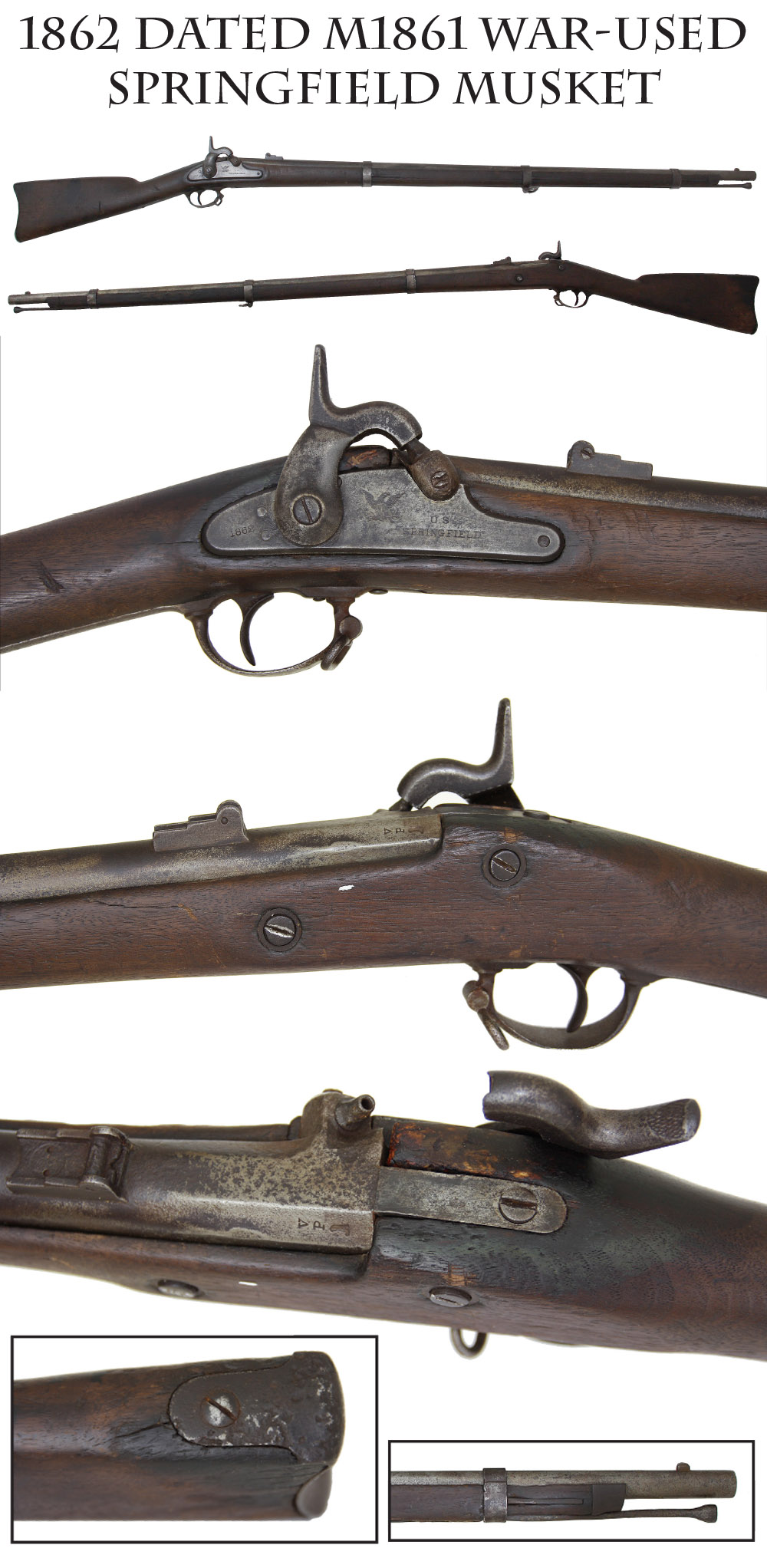
15-08-07 … 1862 Dated M1861 Springfield …
The classic infantry longarm of the Civil War. A real veteran of wartime service. Very clear US Springfield and Springfield eagle marked lockplate with a clear 1862 date at rear of lockplate with sharp VP barrel proofs next to an eagle head on the left barrel flat. Somewhat rounded edges to the lock platform and offside from real wartime use and handling, just as we would expect on an 1862 dated rifle. Cartouches and barrel date are completely worn away. . Good nipple, with corrosion next to it and some light flame damage to the wood next to it- again, good signs of field use. Bands, springs, swivels, swelled ramrod, and both sights in place, the rear sight being the late 1862 pattern without the stepped base, and having a rounded profile at the rear. Some corrosion and dings on the buttplate, and a small crack on the top at the buttplate tang. Most of the metal a deep gray with brown overwash, the buttplate more brown. This musket is a real veteran, showing great age and use… no question this gun fought Johnny Reb and then some. Heck it may have been captured and fought Billy Yank too. Very affordable … fjj
… $895.00 – SOLD
Click Here to E-mail Us!
Call us @ 419-842-1863
~~~~~~~~~~~~~~~~~~~~~~~~~~~~~~~~~~~~~~~~~~~~~~~~~~~~~~~~~~~~~~~~~~~~~~
NOTE: In case you did not know this trick….
To enlarge the photos hold down the control key and press the + (plus) key a couple times. To return to the standard size hold down the control key and press the – (minus) key a couple times.
~~~~~~~~~~~~~~~~~~~~~~~~~~~~~~~~~~~~~~~~~~~~~~~~~~~~~~~~~~~~~~~~~~~~~~

15-08-08 … Superb Sinclair Hamilton Marked 1862 Dated Confederate Imported Enfield …
Top shelf example of a real Johnny Reb Enfield musket. Enfield Pattern 1853 rifles were the foreign arms imported in the greatest numbers during the Civil War by both sides and they have become a hot ticket since it is now possible to identify the Confederate view marks. This is a super example bearing a stamp just above the buttplate tang showing a crown over an “SH/G3” that is identified on page 116 of the new Confederate reference book
“The English Connection”
as a Confederate view mark of the Sinclair Hamilton firm, and another mark on the offside opposite the lock that is a script “J.C.” in an oval identified on page 117 as another Confederate view mark appearing “on almost all “SH”/”G3″ marked arms”. Sinclair Hamilton shipped exclusively to the Confederate states so the marking is highly desirable. The wood has very good edges, typical British light brown color, one small chip below the lockplate. Stock (or gun) makers stamp on underside reads “Taylor & Newman”. Taylor & Newman hailed from Birmingham and are listed in the directories as
Gun, Rifle & Pistol Makers
. They were established in 1861 and remained in business until 1883 located at 270 Newtown Road. The metal shows a very pleasing thin faded plum patina overall. Both sights are in place, with good color to the rear sight. Brass has a mellow patina. All swivels, bands, and the rod are present as well. Clear London proofs on left side of barrel. I have not disassembled the gun but there is likely a barrel maker’s stamp on the bottom. A classic Johnny Reb longarm in great condition. 100% original, 100% complete, and mechanically perfect.
;
One heck of a nice Confederate blockade run Enfield. If this were a standard P53 used by a northern soldier it would bring $1800 easily. As a Confederate Sinclair/Hamilton it has a value a least double that amount, some dealers triple the value. I bought it “right” and will sell it for
… $3,250.00 – SOLD
Click Here to E-mail Us!
Call us @ 419-842-1863
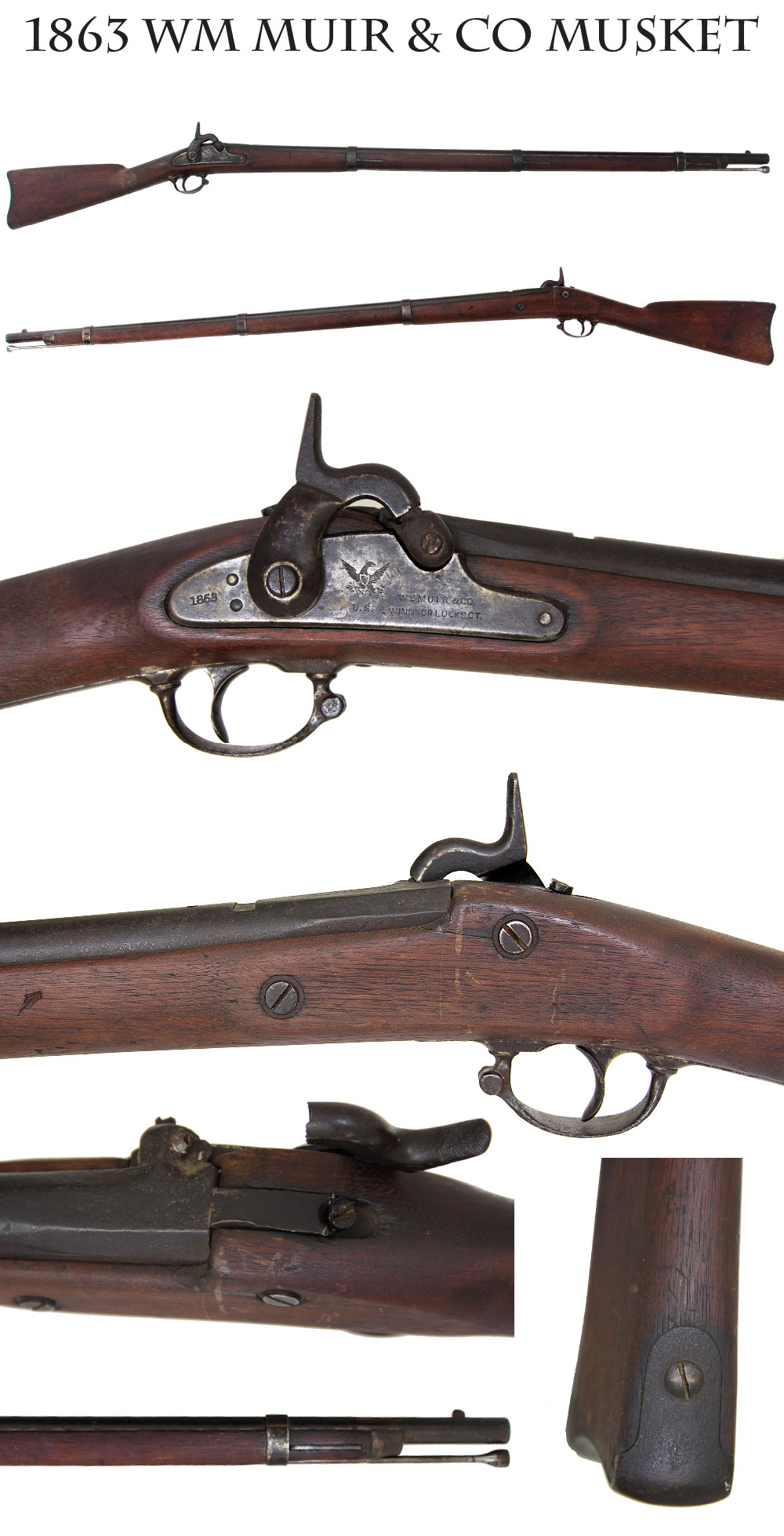
15-08-09 … 1863 William Muir Contract Rifle Musket …
Well worn M1861 contract Springfield. Wm. Muir worked in Windsor Locks, Connecticut, and supplied 30,000 model 1861 rifle muskets to the government in 1863 and 1864. Ours has very clear lockplate markings showing he Muir company name, location and 1863 manufacture date. Bands and springs are present, as is the front sight. The swivels and rear sight were removed at some point. The wood shows rounding from handling and use, but preserves signs of a rectangular cartouche on the offside. Slight crack at the upper lockscrew. Nipple is somewhat battered down and the tip of the breechplug tang has broken off at the screw hole and the tang shows vise indentations. The barrel proofs can still be made out. Bands and springs present. The rod is a modern copy. A basic starter Civil War rifle at a price you can’t beat … bjj-mil
… $495.00 – SOLD
Click Here to E-mail Us!
Call us @ 419-842-1863

15-08-10 … Import .69 Caliber Bayonet …
Nice clean bayonet for one of the .69 Caliber Civil War imports. “AS” marked blade near the neck, “FV” marked locking ring, and other view or inspector stamps on the neck just below the socket. I believe this fits a French pattern 42 or similar musket. Locking ring is functional. Metal is smooth with a dull grayish brown patina. Every long arm was issued with its bayonet as part of the “stand of arms.” They present the same variety and opportunity for collecting as do the muskets themselves. Mowbray has just published a book on the European import bayonets that will probably make sneaking these out of gunshow from an unknowing dealer a lot more difficult … ff
… $140.00 – SOLD
Click Here to E-mail Us!
Call us @ 419-842-1863
~~~~~~~~~~~~~~~~~~~~~~~~~~~~~~~~~~~~~~~~~~~~~~~~~~~~~~~~~~~~~~~~~~~~~~
NOTE: In case you did not know this trick….
To enlarge the photos hold down the control key and press the + (plus) key a couple times. To return to the standard size hold down the control key and press the – (minus) key a couple times.
~~~~~~~~~~~~~~~~~~~~~~~~~~~~~~~~~~~~~~~~~~~~~~~~~~~~~~~~~~~~~~~~~~~~~~

Four different and scarce cartridge packs for Civil War era revolvers:
Very affordable when compared to full unopened packs … and equally as displayable as the multi hundred dollar versions.
15-08-11A … TOP LEFT – 5 Cartridges Colt Police Pistol …
Leet and Hall manufactured pack of five “seamless skin cartridges for Colt’s Police Pistol 36-100 caliber. Patented Feb. 11, 1862.” Portion of label gone at the lower right, but the balance is very good. Empty package perfect for display with a Colt 1862 Police … cow
… $145.00
15-08-11B … TOP RIGHT – 6 Cartridges Remington Navy …
“Six Johnston and Dow Waterproof and Combustible Cartridges for Remington’s Navy Revolvers.” Interestingly, they specify the caliber as .38 rather than .36. Clear October 1, 1861, patent date and Remington factory address. Scarce package. Empty … cow
… $195.00
15-08-11C … BOTTOM LEFT – 6 CartridgesWhitney or Colt Pistol …
“6 Cartridges for Whitney’s or Colt’s Pistol 44-100 caliber. Nice clear black text on cream color paper. Not maker marked and strange that the label states “Whitney’s or Colts” … as I am unfamiliar with any 44 caliber Whitney Army revolvers. The cartridge maker apparently was ignorant of the fact. Ignorant and anonymous. A very visual CW pack for the army revolvers. 44 caliber packages are always scarcer than the smaller calibers. Great label. Empty … cow
… $265.00
15-08-11D … BOTTOM RIGHT – 5 Cartridges Colt Whitney or Remington …
Leet and Hall manufactured pack of five .31 caliber cartridges specified for Colt, Whitney or Remington revolvers. February 11, 1862, patent date. Some missing paper upper right and right center, but only very minor loss to the text. Empty. Perfect to add to a pocket revolver casing … cow
… $185.00
Click Here to E-mail Us!
Call us @ 419-842-1863

15-08-12 … Spanish American War of Daniel L Miller, Co. H, 2nd Regiment, OVI …
Nice family archive of material related to a Spanish American War soldier David L. Miller, who enrolled in April, 1898, in the 2nd Ohio Infantry, and his father a Civil War veteran. Miller signed up for two years and served until the regiment mustered out in February, 1899. His discharge is preserved in the group and he is noted for honest and faithful service in the “remarks” section of his military record. He served in Co. H, which recruited in Bloomdale. Miller also preserved his infantry corporal chevrons, white on blue wool, in good condition, and his mess gear: his 1874 pattern army cup with his initials and company letter scratched in the bottom, his folding mess tin with locations the regiment was stationed scratched inside the bottom portion, and his spoon, fork and knife, the last two with their leather sleeves. He also preserved an example of the fabled army hardtack cracker in a folded envelope in the mess tin. It is still there, but a little worse for the years- broken into a number of pieces, but still a good representation of army fare. Along with these items he kept his comb, which has his initials and unit along the top. The neatest artifact is a red and white towel with Miller’s name and unit stitched into it along the lower edge- a neat piece of camp gear that is very unlikely to survive. Three photos of soldiers who must be friends and might even include him are also in the group. One view is a camp scene of five corporals outside a tent, with knapsacks arranged behind a stack of guns clearly showing the regimental number “2.” A second group shows the same five corporals posed in studio view with an Ohio photographer’s stamp at bottom of the cabinet card. The last is a tintype showing three soldiers in a studio shot imitating a camp scene. They seem to be a sergeant, corporal and private. Miller also kept some souvenir cartridges, an Ohio National Guard marksman medal, and a small box with some Ohio buttons and thread. There is a fragmentary Indiana CW veterans’ reunion ribbon with a celluloid portrait of Lincoln, an Ohio delegate badge, a printing block with McClellan’s portrait, a small round tintype of a man (his father?) in civilian clothes that looks about 1860 and a civilian powder flask of the same period. The powder flask accompanies a brown ink tag reading “Powder flask J. W. Miller 1861 to D. L. Miller”… dad was a CW vet and son a SAW vet. Miller’s service was entirely in the states. The regiment spent most of its service at Camp Thomas on the old Civil War battlefield of Chickamauga in Georgia. However, by August, 1898, living conditions at the camp had deteriorated to such a degree that units stationed there were relocated and the Second was sent to Knoxville, Tenn., where it would remain until February, 1899, when it was sent to Macon, Ga., for muster out. They had not seen enemy action, but fourteen of their comrades had died of disease, a sacrifice for their country even if not made on a battlefield. Miller may have been involved in creating a history of the unit or with its reunions. A typewritten company roster of the original members of the company appears on the reverse of a piece of Goodyear and Miller stationery. An interesting grouping with lots of pieces and very displayable
… $950.00
Click Here to E-mail Us!
Call us @ 419-842-1863

15-08-13 … Framed Large Framed Civil War Photograph of an Army Camp with Fairfax Seminary in the Background …
The Fairfax Episcopal Seminary was taken over at the beginning of the war as army Headquarters by McClellan. It was subsequently used as a hospital and became the General Hospital Headquarters for the Army of the Potomac. This is a nice outdoor albumen photograph showing the impressive building in the distance and an army wagon in the left foreground with a line of tents with some stacked muskets and soldiers standing around. In the right middle distance is another shorter row of tents and in middle ground two army ambulances are parked with some soldiers near them and the horses of one just visible beyond. There is scattered foxing and a slight water stain at bottom center just touching one of the tents. On the reverse in period pencil is “Fairfax Seminary / Near Alexandria / Va” and one more line below that which I can’t make out. A nice view of what the countryside around Washington really looked like at the time. Image is roughly 7×8, housed in an 11×12 frame … aej-lucas
… $265.00 – SOLD
Click Here to E-mail Us!
Call us @ 419-842-1863
~~~~~~~~~~~~~~~~~~~~~~~~~~~~~~~~~~~~~~~~~~~~~~~~~~~~~~~~~~~~~~~~~~~~~~
NOTE: In case you did not know this trick….
To enlarge the photos hold down the control key and press the + (plus) key a couple times. To return to the standard size hold down the control key and press the – (minus) key a couple times.
~~~~~~~~~~~~~~~~~~~~~~~~~~~~~~~~~~~~~~~~~~~~~~~~~~~~~~~~~~~~~~~~~~~~~~
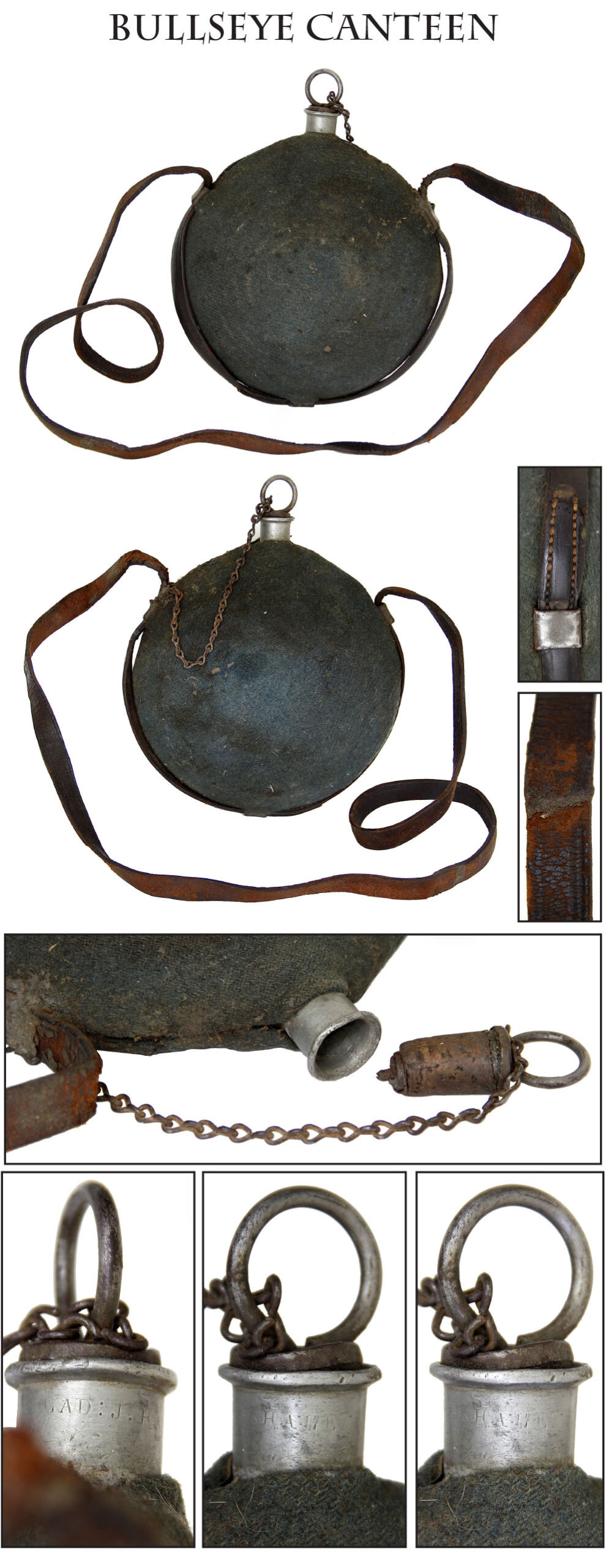
15-08-14 … Superb Sky Blue Civil War Bullseye Canteen with Leather Strap and Stopper …
One of the best canteens I’ve found in the last couple years … I was unaware Arthur was photographing it for the list, otherwise I would have postponed selling it for a while because I like it so well. I paid him for the photo work so I’ll leave it on the list … Civil War 1858 pattern canteens were covered in a variety of materials and colors, but light blue ones have always been among the hardest to find and most sought after. This one is excellent with only a few scattered moth nips and staining from real issue and use. It still preserves its color beautifully. The canteen itself is a Philadelphia depot contract canteen. The spout shows parts of a stamp reading “J. HALL… PHILAD.” which is the stamp of J. Hall Rohrman, who supplied canteens to that depot. It has a leather strap on it, which is a wonderful soldier done wartime modification. The strap has a break mended by a collector with a simple skived repair, otherwise excellent. Original stopper is also present. This canteen was unquestionably carried by Billy Yank in the field … marked PHILA J. HALL … cge
… $595.00 – SOLD
Click Here to E-mail Us!
Call us @ 419-842-1863

15-08-15 … Rare Horse Gear! Identified New York Artillery Officer’s Martingale With Super Tag …
Battle Service in Virginia and North Carolina … One of the most interesting pieces of horse equipment to present itself to me in recent years. An incredibly scarce piece of horse gear with a regimental numeral on the chest shield, red color to the leather for branch of service, and a dead real note identifying it: “Used by Lt. C.F. King /in the Civil War / 3d N.Y. Lt. Arty.” New York fielded both independent batteries of artillery and regiments of artillery. Most of the NY regiments were heavy artillery with the exception of the first and third regiments whose companies served as individual batteries. Charles F. King enrolled at age 21 on 10/17/61 at Lee Center for 3 years and mustered in as a private in Battery H 11/16/61. He made sergeant 1/9/62 and was commissioned 2nd Lieutenant 1/8/64 with rank from 12/3/63 and officially mustered in at that rank as of 12/4/63. He served until mustered out 11/24/64. During King’s service the battery served in North Carolina and Virginia as part of the Artillery brigade of the 18th Army Corps, seeing action on the expedition from New Bern to Goldsboro at Kinston, White Hall and other fights. In 1863 it saw action at Wise’s Crossroads, Gum Swamp, Swift Creek and other engagements, and in 1864 served in front of Petersburg and Richmond. The breast strap is in very good shape, really nice. One small loop has loosened on one side, and there is a period repair to one of the straps securing the bone rings that ride on the reins. The horseshoe shaped buckles are present and the red color of the breast band and of the central shield is quite strong. Prominently displayed is a large brass numeral “3” on the shield panel for the Third NY Artillery. This is a very showy piece that would look great in an artillery display or any collection of mounted gear. We see post Civil War examples, or examples of undeterminable age every so often. But finding one that is absolutely Civil War and identified to boot is pretty darn rare. I do not recall the last time I saw an identified example on the market
… On Hold
Click Here to E-mail Us!
Call us @ 419-842-1863

15-08-16 … High Quality Commercial 1860s Gun Belt …
This has a real southern flavor to it. I envision it being worn by a dashing southern scoundrel like Rhett Butler, but it certainly could have been used by a military man as well, or a very early 1860s western cowboy or adventurer. About as interesting a gun belt as I’ve seen in recent times. The holster construction is very similar to known CS holsters. Nice harness leather holster fits a Colt navy or army revolver, butt-to-the-rear. It has a full flap that secures by means of a leather billet that passes through a standing loop to keep the flap closed. The billet is pointed at the end and is secured to the flap by a fancy brass “gewgaw” of geometric and floral designs. The single narrow belt loop on the reverse is likewise pointed with bullet stitching and is additionally secured by a single rivet. There is a nice reinforced area over the muzzle end of the holster. It appears to have been part of the original design, but could possibly have been a modification by the wearer during the rigs period of use. The belt is a simple undecorated affair with a roller buckle and standing loop secured by stitching only. It has been with the holster forever. This has a great look. One small area of damage where the pistol hammer wore through the closed flap. If you’re looking for a spectacular 1860s gun belt — this be the one …noco
… $1,450.00 – SOLD
Click Here to E-mail Us!
Call us @ 419-842-1863

15-08-17 … Tiffany and Company Cavalry Saber and Scabbard …
Regulation 1840 style heavy cavalry saber as supplied by Tiffany and Company with their characteristic iron hilt. “Tiffany & Co. / New-York” stamp on one side of the ricasso and “PDL” cartouche on the other side. PDL is Solingen maker Peter Lunenschloss, who supplied many blades to US makers and military goods dealers. Has full black leather grip wrap and brass wire overall VG with just a little chipping on some high spots on the leather. Steel hilt overall dark gray patina with some lighter patches. Blade and scabbard match with light silver gray patina for the most part. Blade is VG to fine with no edge damage or nicks and a nice smooth surface. The scabbard exhibits gentle surface pitting overall, not noticeable as the color is a uniform steel grey. A nice example of a scarce form of the 1840 supplied by Tiffany in the Civil War. Much cheaper than my competition … djj-mil
… $695.00 – SOLD
Click Here to E-mail Us!
Call us @ 419-842-1863
~~~~~~~~~~~~~~~~~~~~~~~~~~~~~~~~~~~~~~~~~~~~~~~~~~~~~~~~~~~~~~~~~~~~~~
NOTE: In case you did not know this trick….
To enlarge the photos hold down the control key and press the + (plus) key a couple times. To return to the standard size hold down the control key and press the – (minus) key a couple times.
~~~~~~~~~~~~~~~~~~~~~~~~~~~~~~~~~~~~~~~~~~~~~~~~~~~~~~~~~~~~~~~~~~~~~~

15-08-18 … 43rd Mass. Presentation Sword and Signed CDV of the Officer With the Sword! North Carolina Battle Action …
A nice opportunity to acquire an inscribed presentation 1850 foot officer’s sword along with a signed photograph of the officer carrying it. The sword is a fine regulation 1850 foot officer’s pattern, with a bright blade and vivid, profuse etching showing a flowing US on one side of the blade near the hilt and an E PLURIBUS UNUM ribband under a US shield and stars-and-stripes flag on the other. These are mixed in with various floral and geometric motifs that cover about two-thirds of the blade on each side and also include an American eagle with another ribband at the midpoint. A lion is on the other side, which is significant (see below). The grip is leather wrapped with a strand of twisted wire binding in place. The brass has a mellow undisturbed patina that shows some original gilding in recesses. This matches the brass mounts on the scabbard, which is black leather, complete and unbroken with upper, middle and lower mounts firmly in place. Beautifully inscribed on the upper mount is: “Fred. B. Wentworth / to / Henry A. Turner / RQM /43d Reg. / Mass Vols.” Accompanying this is a photo of Turner. The signed CDV portrait of Turner shows him in full uniform posed next to a column and balustrade, wearing his frock coat with 1st Lt. straps, tall boots and gauntlets, his forage cap in hand and with his officer’s sash and sword belt, from which hangs this 1850 sword. The card is boldly signed at bottom: “Yours Truly QM 43d Mass Henry A Turner” and bears a Silsbee, Case & Co. backmark from Boston.
The 43rd Massachusetts regiment was raised in 1862 to answer the government’s call for nine month troops and had as its nucleus the Second Battalion Massachusetts Volunteer Militia. Company A of this unit had a long history as the “Boston Light Infantry,” which was nicknamed the “Tigers.” This led to the entire regiment adopting the nickname, “The Tiger Regiment”, and other swords from this unit are known with engraved tigers… I owned one pre war example so engraved on the brass guard. Comically, the artist etching Turner’s sword was either a little sketchy on the animal kingdom, or his pattern book did not show a tiger. In either case, he opted for a lion on the blade. This is the first US sword I recall owning with a lion as part of the blade decoration, and it is a pretty impressive bit of etching. The regiment was sent to New Bern, NC, where it arrived in November, 1862. In December it took part in the 180-mile Goldsboro expedition, where it saw action and took casualties at Kinston, Whitehall and Goldsboro. Thereafter performed picket and guard duty, but was again called into the field on the relief expedition to Little Washington. The regiment returned to Boston and mustered out in July.
Henry Augustus Turner resided in Boston and was a 38 year-old merchant who enlisted 10/14/62 and was commissioned a 1st Lieutenant and Quartermaster in the Field and Staff of the 43rd Mass on 10/25/62. He was wounded on or about 11/25/62, resulting in the amputation of his right foot. He must have been a tough bird, for he returned to duty 12/21/62 and served until muster out 7/30/63 at Readville, Mass. After the war he lived in Boston and died in 1901 in Cohasset. The sword’s presenter Fred. B. Wentworth was undoubtedly a good personal friend of Turner’s. He shows up as a member of Boston’s Ancient and Honorable Artillery, another ages old Boston militia unit going back to the 18th century. Blue bloods both I assume. A nicely identified officer’s sword with the rare bonus of a photograph of the officer with the sword … xbcx
… $2950.00 – SOLD
Click Here to E-mail Us!
Call us @ 419-842-1863

15-08-19 … Confederate $500 Bond …
Excellent as shown. Equestrian motif at top. Size of bond proper is 10 1/2″ X 17″, not including the coupons. The fifteen dollar coupons are attached except for one that was redeemed … noco
… $40.00 – SOLD
Click Here to E-mail Us!
Call us @ 419-842-1863

15-08-20 … 1863 Confederate $500 Bond …
Overall excellent as shown. Size of bond proper is 10 1/2″ X 17″, not including the coupons. Eight twenty dollar coupons intact … $20 increments … noco
… $40.00 – SOLD
Click Here to E-mail Us!
Call us @ 419-842-1863
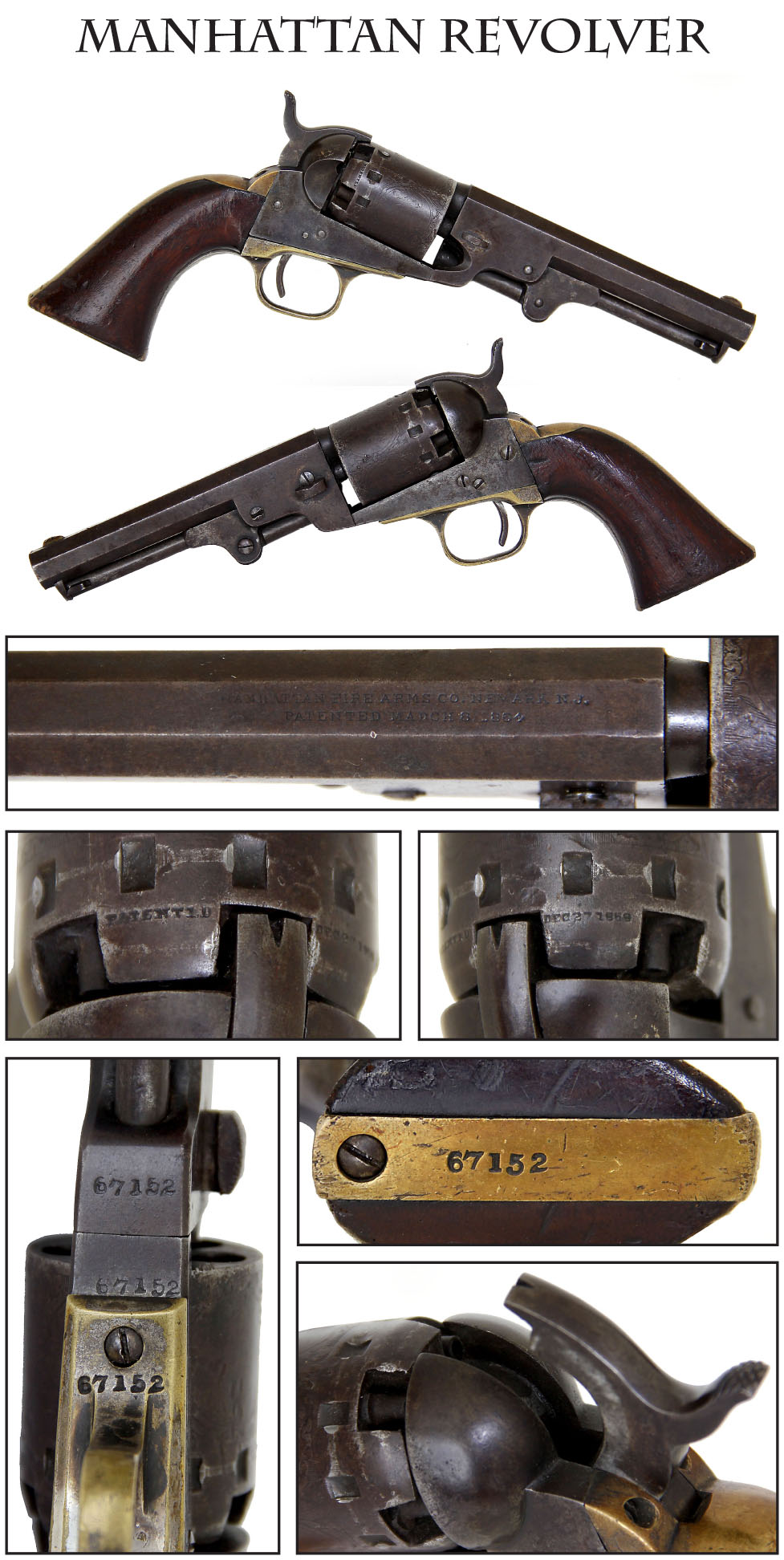
15-08-21 … Manhattan Navy Revolver …
Very nice condition Manhattan .36 caliber, 5-shot revolver with five inch barrel. Serial number 67152. Clear markings with two-line barrel address with 1864 patent date and 1858 patent date on cylinder. Nice color showing blue turned to plum-brown overall and some light faded case on the frame, particularly the right side. Grips very good with tight fit to metal, just a little wear high up on the shoulders and one indentation on the left at the frame. Some light traces of silver on the brass triggerguard. Matching serial numbers throughout and mechanically perfect. These were popular sidearms and the company produced about 78,000 of them in various models from 1859-1868. A nice late war or early western revolver. Every bit as handsome as a Colt but only half the price … sn 67152 … f-veg
… $850.00 – SOLD
Click Here to E-mail Us!
Call us @ 419-842-1863
~~~~~~~~~~~~~~~~~~~~~~~~~~~~~~~~~~~~~~~~~~~~~~~~~~~~~~~~~~~~~~~~~~~~~~
NOTE: In case you did not know this trick….
To enlarge the photos hold down the control key and press the + (plus) key a couple times. To return to the standard size hold down the control key and press the – (minus) key a couple times.
~~~~~~~~~~~~~~~~~~~~~~~~~~~~~~~~~~~~~~~~~~~~~~~~~~~~~~~~~~~~~~~~~~~~~~
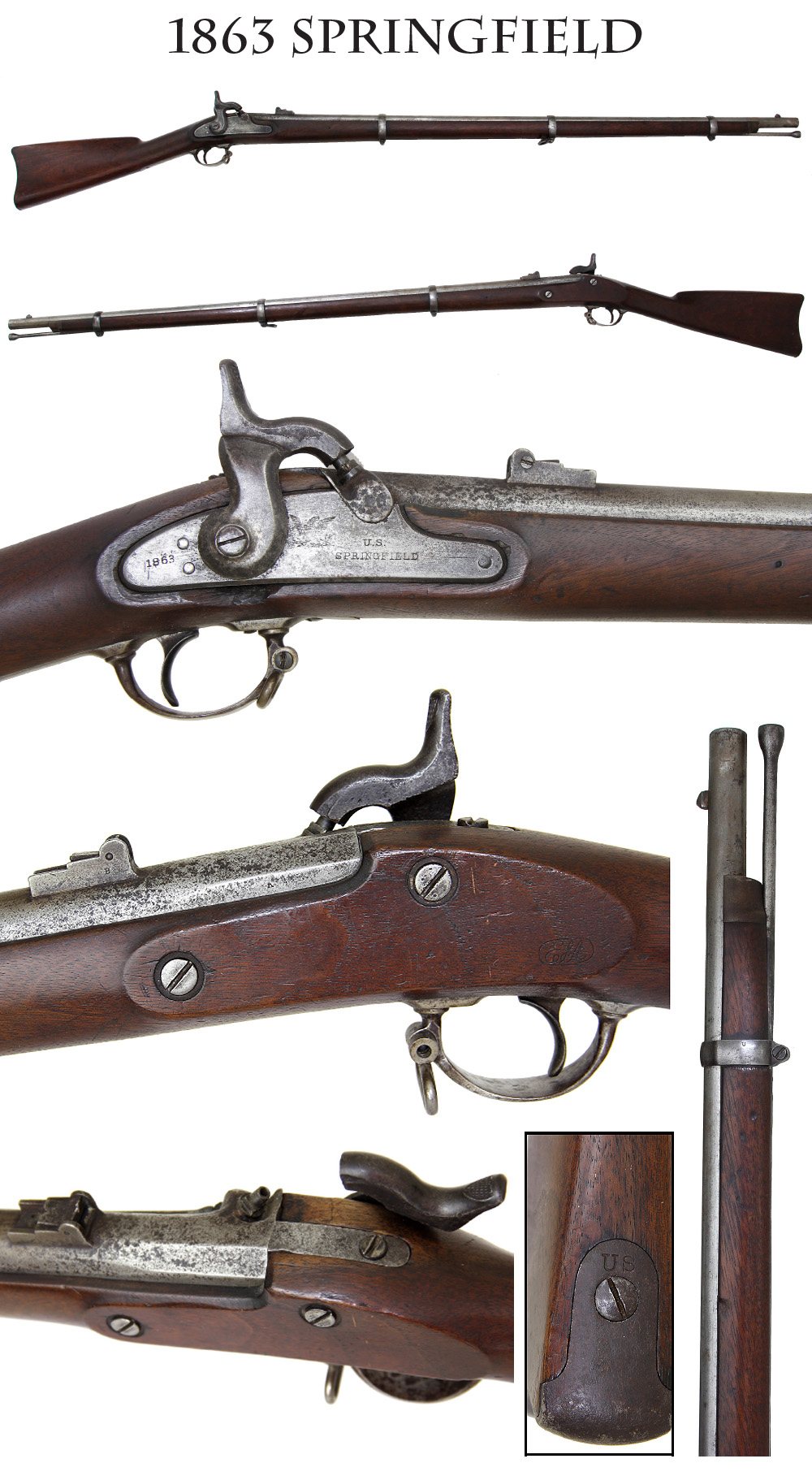
15-08-22 … 1863 Springfield …
Model 1863 Springfield Type-I rifle musket with 1863 date. This variation of the 1861 Springfield incorporated several features of the 1861 Special Model as produced by Colt. Most notably is the S-shaped beveled hammer and the use of split barrel bands secured by tightening screws, eliminating the need for retaining springs in the stock. Springfield produced 273,265 of them during 1863 and they are thus a prime variant of the standard US infantry long arm. This one shows definite use, but is still in very good shape with good edges to the wood, tight fit to the metal and very clear “ESA” inspector cartouche on the offside. There is some dappled corrosion pitting from firing on the bolster and just forward of the nipple, just enough to show it was issued and used. The metal overall is a dull silver with dark gray spots mainly near the breech. Both sights in place, as are all bands, swivels and rod. Rear sling swivel is replaced. A little bit of light color and a singe mark near the nipple, but the wood is not burnt out. Clear eagle and barrel proofs. Date and US/Springfield on lockplate are clear. Eagle a tad rubbed at center. Bolster corrosion makes that eagle hard to see. Buttplate shows a bit dark, but is not pitted and the fit to the wood is tight. The only real defect is a small piece of wood out just below the hammer. This could be easily fixed and rendered invisible, but the dark wood shows it is old damage, and I have left it as is. A good mid-war infantry long-arm. Very affordable … ajjj-gper
… $1,295.00 – SOLD
Click Here to E-mail Us!
Call us @ 419-842-1863
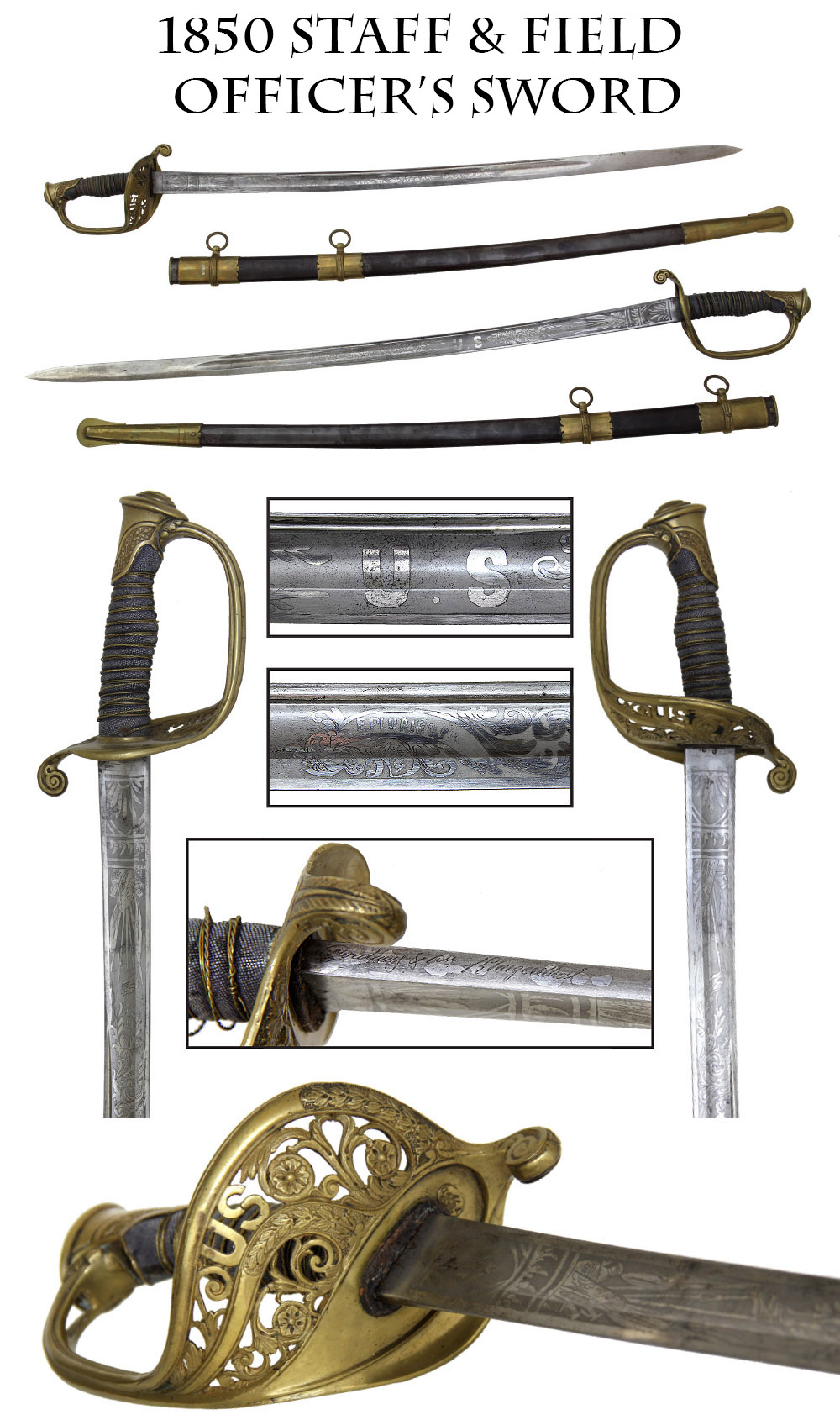
15-08-23 … 1850 Staff and Field Officer’s Sword …
The 1850 staff and field swords were intended for regimental field grade officers (major and above) and members of the staff such as the Adjutant and Quartermaster, who were mounted. The blades are a tad longer than the foot officer’s swords and the scabbards are metal rather than leather, the better to withstand the rigors of wear while mounted. The elaborate brass guards incorporate a “US” amid the decorative foliage of the branches and counterguard, making it more visually exciting than the more common foot swords. This one has very vivid blade etching with a US on one side amid geometric and floral motifs and an E PLURIBUS UNUM ribbon on the other. The blade shows bright, with just the smallest amount of gray in small spots near the tip and a few mixed with the etching ground that do not show much. The edge has no damage or nicks. The scabbard still shows much of its original blue and the brass mounts match the sword hilt with a mellow patina. The three-strand wire wrap on the grip is broken in one spot and is currently loose, but this can be repaired. I just don’t have the time to have it done before this list hits the email blast. The sharkskin grip wrap is complete and nice. The spine of the blade shows the Klingenthal dry point engraved maker’s name indicating this is a French product intended for the American market. This would look great with an officer’s sash and field-grade straps beside it … g-15491
… $975.00 – SOLD
Click Here to E-mail Us!
Call us @ 419-842-1863

15-08-24 … Smith & Wesson No.2 Army Revolver …
Very Good example of the popular rimfire six-inch, six shot pistol with a serial number of 17,390 indicating a good early-war production date. Very popular because of the weather-proof self-contained cartridges. The grips are excellent. The metal shows largely bright and dull silver with some very light sections. Custer owned a pair of these and they were popular with western travelers, gamblers and the like. Even Wild Bill Hickock kept one as a back-up piece. Overall VG. 100% original and complete. Functions fine but you need to point the muzzle toward the ground when cocking to engage the “hand” which rotates the cylinder. A nice example at a friendly price. eej … sn17390 … eej-ahy
… $695.00 – SOLD
Click Here to E-mail Us!
Call us @ 419-842-1863
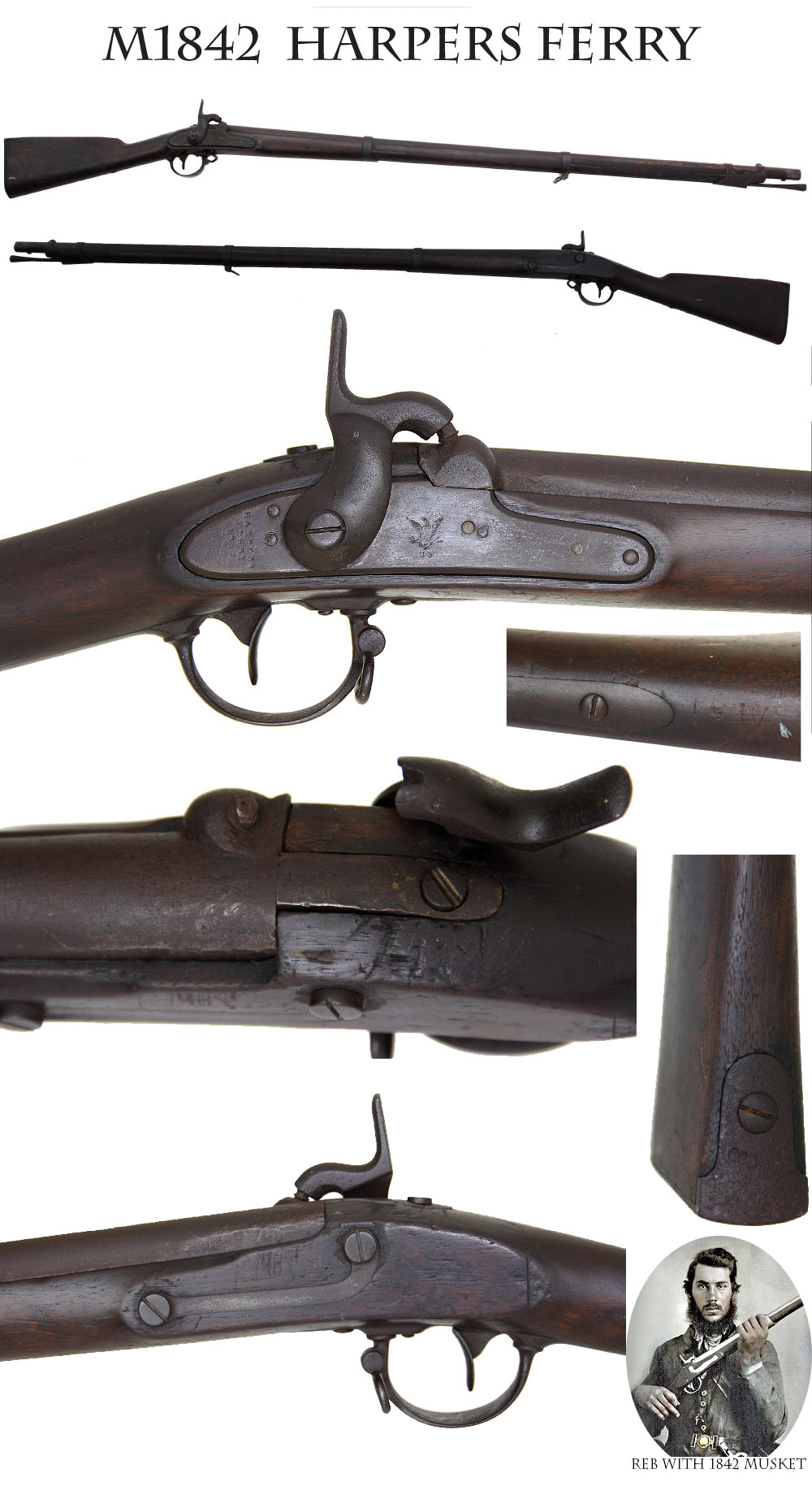
15-08-26 … 1852 Dated Harpers Ferry ’42 Musket …
Weapons produced by the quintessential “southern arsenal” always have a strong collector appeal and southern association given John Brown’s raid on the installation and its seizure by Confederate forces at the beginning of the war, all of which gives the Harpers Ferry longarms a historic and romantic association that Springfield arms have a hard time rivaling. Here is a good example of the well-known 1842 .69 caliber smooth-bore percussion musket. The last of the old large bore infantry arms and the first of the percussion longarms intended for general issue to infantry. This is a well-used and solid example showing its history. The lockplate has some crustiness and pitting, but the Harpers Ferry eagle, US , and the three line Harpers Ferry 1852 stamp are legible. Good action. The nipple is battered and broken but that is the only defect of any consequence. The breech shows corrosion from the fulminate of mercury in the percussion caps going off. The barrel proofs are present and under some ancient barrel crust. The date on the barrel tang is likewise under a lot of crust with 18 visible and the last two digits obscured. Some rounding to wood edges, as should be expected from a well used musket, and some dings and scratches, none too obtrusive but there is a deeper vertical scratch on the offside aft of the lockplate screws. Rectangular cartouche visible on left side. Swivels, bands, springs, rod and bayonet stud all in place. A true old warrior. Very solid … noco
… $1,350.00
Click Here to E-mail Us!
Call us @ 419-842-1863
~~~~~~~~~~~~~~~~~~~~~~~~~~~~~~~~~~~~~~~~~~~~~~~~~~~~~~~~~~~~~~~~~~~~~~
NOTE: In case you did not know this trick….
To enlarge the photos hold down the control key and press the + (plus) key a couple times. To return to the standard size hold down the control key and press the – (minus) key a couple times.
~~~~~~~~~~~~~~~~~~~~~~~~~~~~~~~~~~~~~~~~~~~~~~~~~~~~~~~~~~~~~~~~~~~~~~
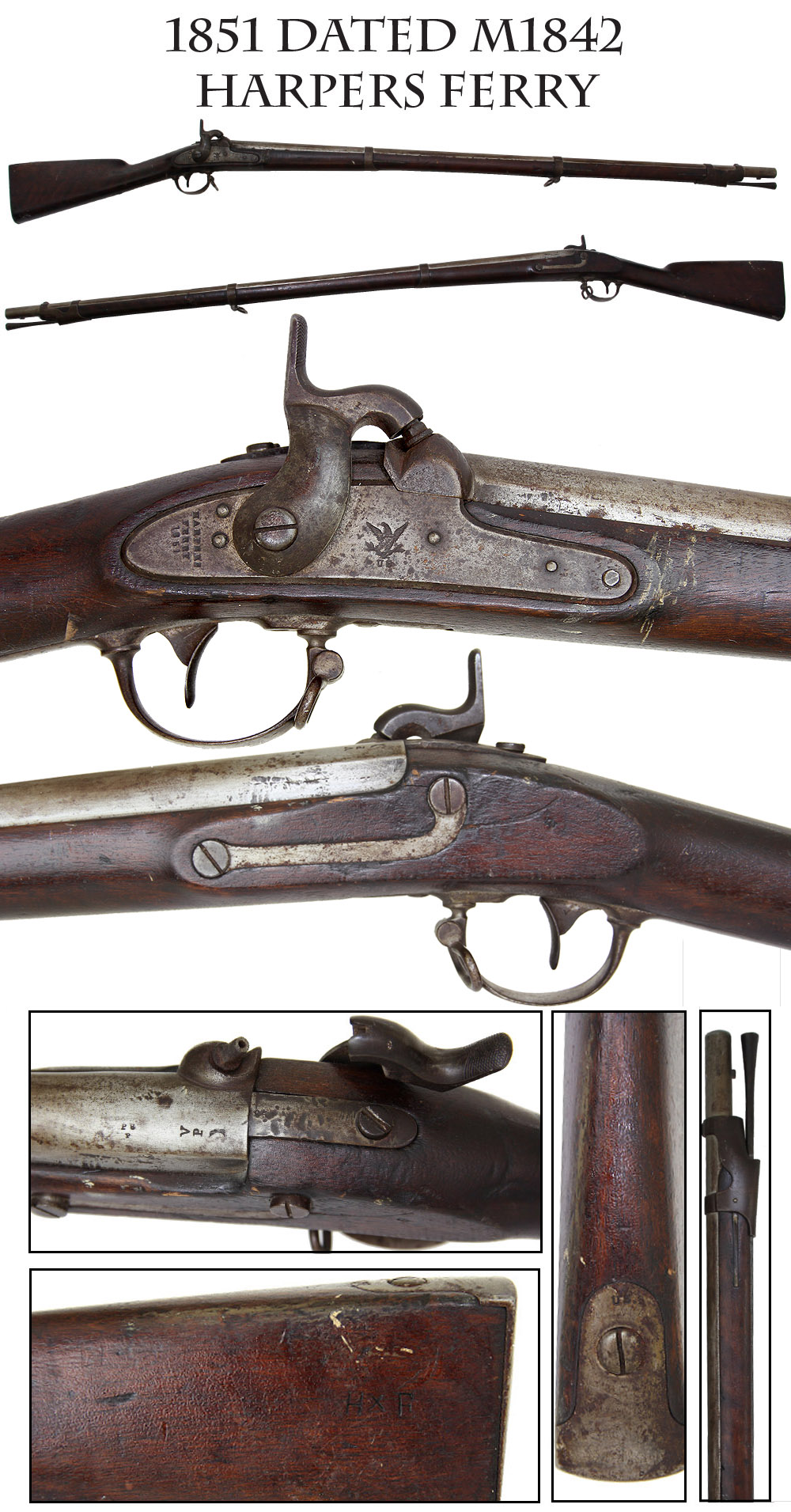
15-08-27 … 1851 Dated M1842 Harpers Ferry …
Another one of those guns that could have ended up in many different hands but has a much stronger southern association, coming from the arsenal at Harpers Ferry, Virginia. This one has a very clear Harpers Ferry eagle over a US forward of the hammer and Harpers Ferry 1851 in three lines aft of the hammer. V/P/eaglehead barrel proofs are very clear at the left breech along with barrel inspector initials just forward of that. Barrel tang has “185-” visible… last digit of the date not legible but presumably a “1”. A few dings on top of the tang. Good action. Nice delicate patina overall with the barrel being less patinated and more gun metal grey. Some very slight rounding to the wood edges of the lock platform and the offside. No cartouches visible. A few abrasion marks and light dings, and a couple of paint spots that will come off from storage in someone’s garage. Bolster and lockplate show mostly dull silver and pewter. A small set of initials, “HxF” scratched in the upper butt flat near the buttplate tang, and what looks like a backwards “S” is stamped in the cartouche area. All bands, springs, swivels, rod and bayonet stud in place. A very respectable example at a livable price … aug14
… $1,450.00
Click Here to E-mail Us!
Call us @ 419-842-1863
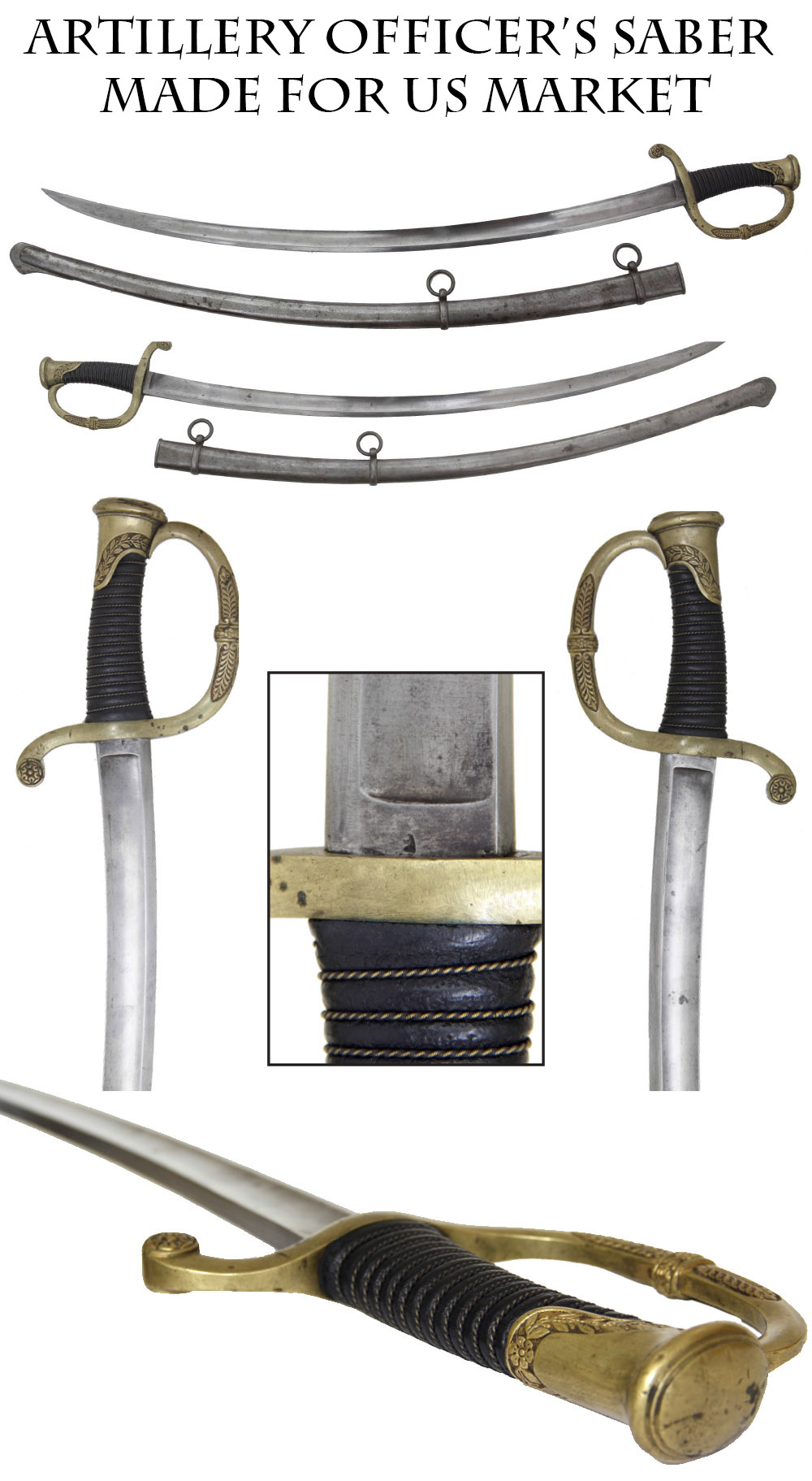
15-08-28 … Artillery Officer’s Saber Made for US Market …
An interesting artillery officer’s saber that is unmarked but shares characteristics with Roby and S&K versions. Artillery officer’s sabers are scarce because of the lower number of officers in that service. Ames made specimens cost the price of a decent used car. Interestingly the 1841 regulations recognized the pattern for use by ordnance officers and “mounted officers artillery and infantry,” i.e., light artillery officers of all ranks and infantry field and staff officers. This changed in the regular army in the 1851 regulations where the pattern was designated exclusively for artillery commissioned officers. This example holds to the Thillman Type-2 form with a conventional scabbard with articulated throat. It is completely unmarked other than a small stamp on the ricasso. The grip is leather wrapped with standard wire binding and follows the 1840 form without a swell. The leaf design on the pommel and on the knuckle guard match up with those of Roby as well as Schnitzler and Kirschbaum products. The blade is plain, unetched, with a good edge and light silver in color with some bright showing through overall. The scabbard is a pewter gray with some darker gray areas, but no dings or dents. The grip seems to be turned wood rather than cord-wrapped and the scabbard throat is soldered rather than riveted, both American characteristics. S&K supplied hilts to other makers according to Thillman… and it appears that this hilt is one of those. This sword was likely assembled in the US by a military goods dealer utilizing imported and American elements. It is a very scarce regulation sword in extremely good condition and suitable for an edged weapons collection, an artillery display, from the Mexican War through the Civil War. Wonderful example … noco
… $1,650.00
Click Here to E-mail Us!
Call us @ 419-842-1863
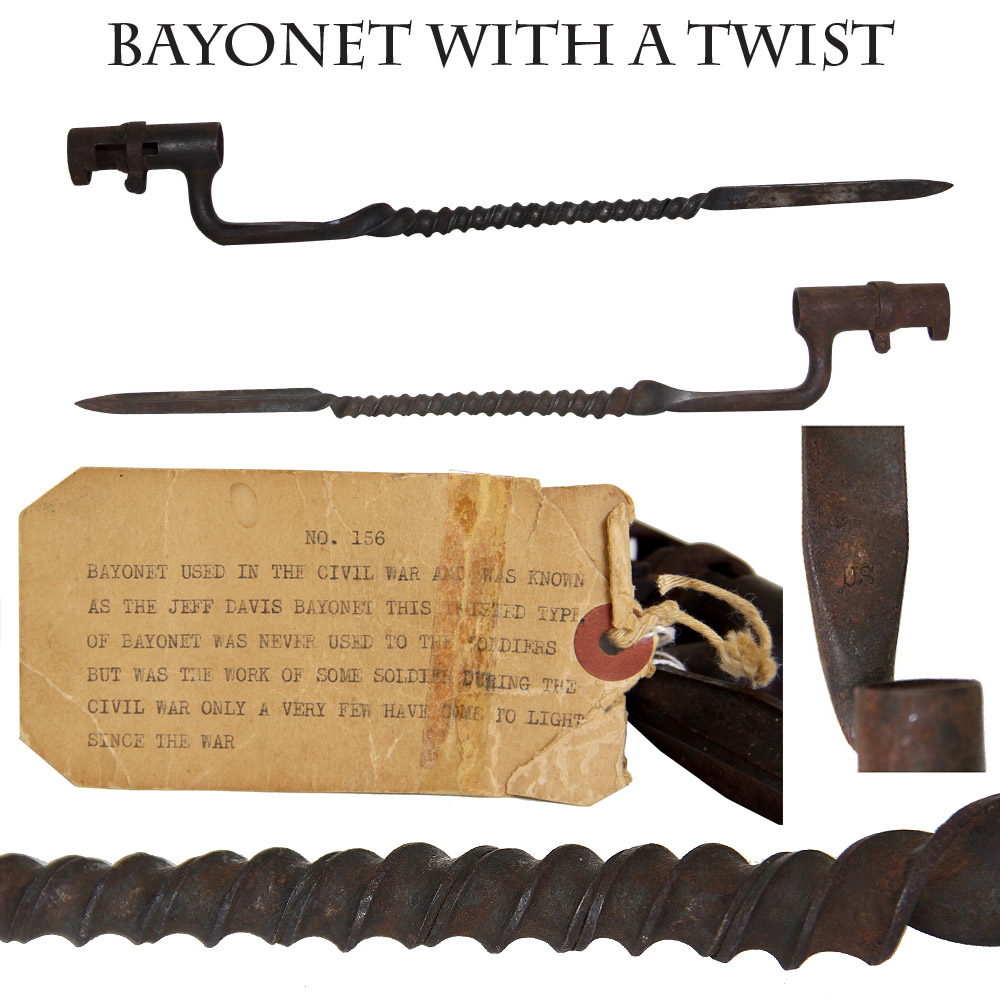
15-08-29 … Bayonet with a Twist …
A wonderful old relic. When I saw it at a local auction I knew I was going to buy it. A regulation Civil War .58 caliber bayonet that a talented blacksmith used as a medium to show off his abilities. After heating it up he worked 17 or 18 twists into the blade making it look like a giant corkscrew. A cool old tag comes with it which bears a collection or display number and a wonderfully fanciful description from a long dead owner calling it a “Jeff Davis bayonet”, implying that it is a known and recognized pattern of pig sticker. The old tag is as much fancy as it is fact and more the better for it. The writer of the tag had great enthusiasm for the story behind this twisted relic but lacked the ability to put his story to words. He could not make up his mind whether it was a known “type” of bayonet that had simply never been “used (issued) to the soldiers,” or if it was the work of a soldier in the field. He did make one totally “spot-on” observation. His tag states “…very few have come to light since the war”… Of that he was 100% correct. I’ve never owned another. It hardly seems the product of a casual evening around a campfire, but certainly a soldier might well have decided his winter hut needed something a little fancier than a plain bayonet stuck in the wall to hold his candle. My guess is that the maker was a cavalry blacksmith who used his portable furnace to heat and twist the work of folk art. He may have done it for himself, or he may have made several for friends in his regiment or brigade. There is a story here somewhere. The piece is a wonderful, folk-art relic, with a great visual impact
… $350.00 – SOLD
Click Here to E-mail Us!
Call us @ 419-842-1863

15-08-30 … Scarce Horstmann 1840 Type-1 Heavy Cavalry Saber and Scabbard …
Clearly marked on the ricasso is the revered name of Horstmann, one of the most prolific US military goods suppliers of the 19th century, who by 1864 had sold more than 25,000 swords to the US Ordnance Department, not to mention the tens of thousands they sold privately and to specific units. Their enlisted cavalry sabers followed the British 1822 pattern, the US 1840 or the US 1860. This is the scarce “Type-1” version of their 1840 pattern in Thillmann’s terminology, produced at the very beginning of the war using blades obtained from Emerson and Silver as a subcontractor to meet their early war contracts. In contrast to Horstmann’s imported sabers, the blade shows an odd wedge shaped stamp on one side of the ricasso and “HORSTMANN / PHILA,” on the other. It has the soldered throat (no rivet), and grip of turned wood under the leather rather than the cord-wrapped smooth wood of the imports. Ours has full leather and twisted wire wrap, with a little chipping on the leather. The leather bumper pad is in place at the blade shoulder, and the blade is overall VG to near fine. Nice smooth grey steel with quite a lot of shine. The scabbard is overall smooth steel with age brown patina and some mottled age spots. A good solid early war cavalry saber … djj-jq-01203
… $675.00
Click Here to E-mail Us!
Call us @ 419-842-1863
~~~~~~~~~~~~~~~~~~~~~~~~~~~~~~~~~~~~~~~~~~~~~~~~~~~~~~~~~~~~~~~~~~~~~~
NOTE: In case you did not know this trick….
To enlarge the photos hold down the control key and press the + (plus) key a couple times. To return to the standard size hold down the control key and press the – (minus) key a couple times.
~~~~~~~~~~~~~~~~~~~~~~~~~~~~~~~~~~~~~~~~~~~~~~~~~~~~~~~~~~~~~~~~~~~~~~

15-08-31-A … Standard Issue Union Infantry Bayonet Scabbard Only …
Classic mid war example of the regulation .58 caliber rifle musket bayonet scabbard. The bayonet shown with it, is just a trapdoor bayonet stuck in it to protect it from bending. My photo man did not know this. Scabbard is solid, just some wear and finish loss to the belt loop from wear and flexing. The frog uses the standard seven rivets in the frog, plus another on the top right corner of the body. Scabbard body solid, with no breaks or bends, good stitching and tight brass tip. There is a tiny pin-hole in the belt frog of no consequence
… $165.00 – SOLD
15-08-31-B … I will sell the trapdoor bayonet too …
Fits the 1873 US Springfield 45/70 rifle. Overall VG with most of the original blue remaining mixed with some light surface rust. This one will clean beautifiully … noco
… $95.00
Click Here to E-mail Us!
Call us @ 419-842-1863

15-08-32 … M1840, 1851 Dated Ames Heavy Cavalry Saber and Scabbard …
M1840 Heavy Cavalry Saber, marked “AMES MFG. CO. / CABOTVILLE /1851” and “US / A.D.K.” … this “wristbreaker” saber and scabbard are both in VG to FINE condition. The blade is without bends, nick free, and has a pleasing aged steel patina. The leather grip has dried out a touch, but looks great, and is in Fine condition with original wire wrapping. The guard is likewise in fine condition as well, with only modest handling wear for its age, and a light patina. The scabbard is likewise in very good condition with a smooth dark brown patina, and no damage or defects of significance … gejyy
… $1,150.00
Click Here to E-mail Us!
Call us @ 419-842-1863
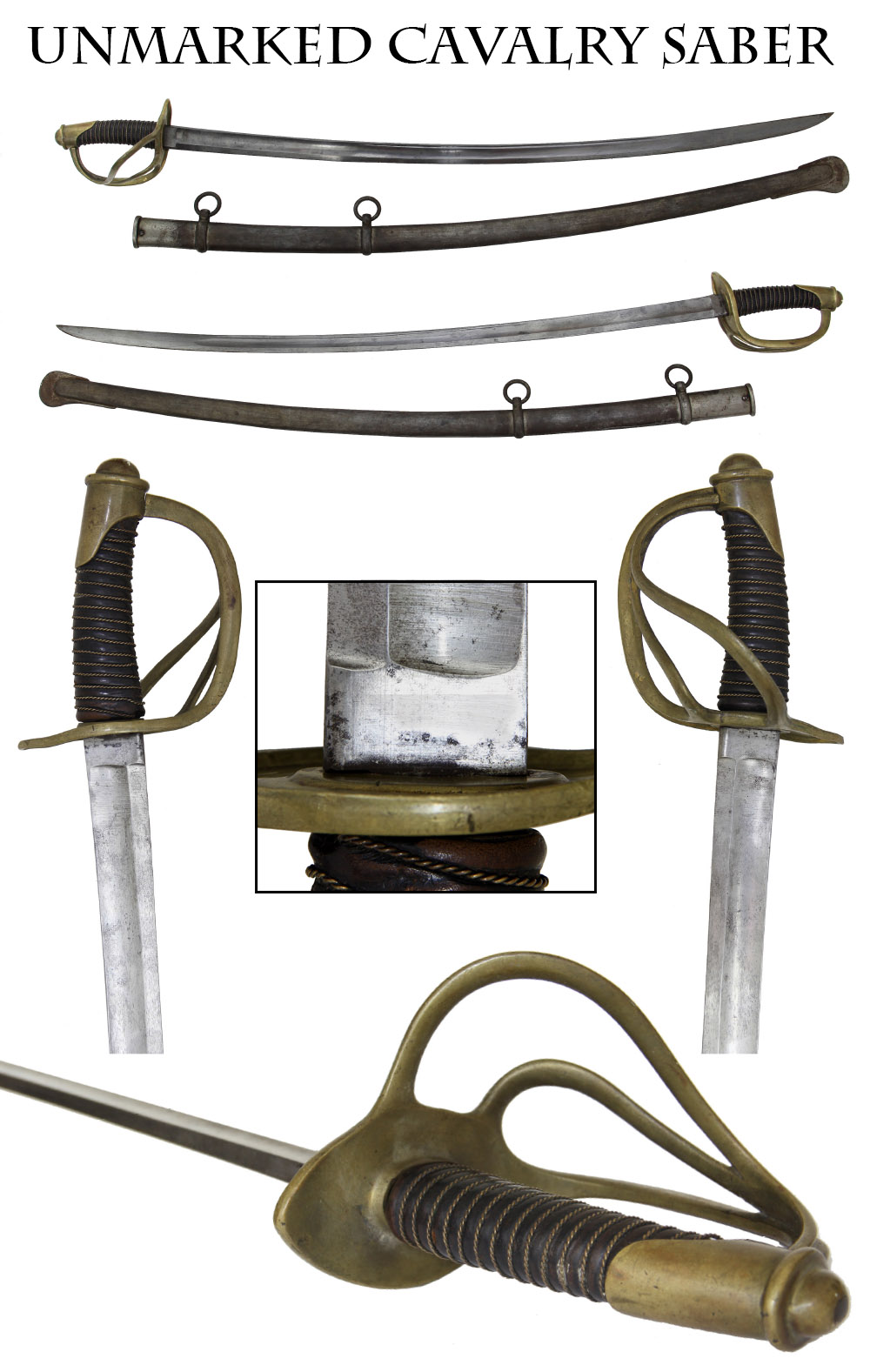
15-08-33 … Unmarked Cavalry Saber …
A nice 1840 pattern heavy cavalry saber and scabbard. No markings, which is frequently the case with swords sold by American military goods dealers and contractors who were importing blades and complete swords from foreign makers (mostly German) until U.S. production could catch up with demand. With only two exceptions these makers produced the 1840 pattern enlisted saber for U.S. dealers. This is a nice example with complete leather wrap showing just a bit of wear near the guard, and full wire. Blade has no nicks or edge wear and is a light silver gray mixed with some bright underneath. Scabbard is very good, no dents, gray mixed with brown. Rings in place, throat secured with a side rivet as is common on the imports. The 1840 was sometimes called the old-wristbreaker, but it was meant for business and many preferred its heft. A good solid early war saber proper to display with Union or Confederate cavalry effects … cjj-mil
… $495.00 – SOLD
Click Here to E-mail Us!
Call us @ 419-842-1863

15-08-34 … 1863 Emerson & Silver 1840 Pattern Musician’s Sword & Scabbard …
These straight bladed swords were intended for wear by musicians in the infantry who had drummer and fifer assigned to each company as well as a regimental band (until the government cut costs and abolished them below brigade level.) Similar to the NCO swords, they are a tad shorter and do not have the semicircular clamshell counterguards. This one has a very nice bright blade with just a few dusty gray clouds here and there. The thin leather pad at the blade shoulder is in place and the markings are very clear: “Emerson / & / Silver / Trenton / N.J.” on one side of the ricasso and U.S. / DFM/ 1863 on the other. In addition to a nice mid-war date the sword has the matching inspector initials both on the brass knuckleguard of the sword and the drag of the scabbard, showing they have been together forever. An additional bonus is that the maker, Emerson and Silver, characteristically used a metal scabbard body rather than a leather one. Just as the soldier did not need to worry about being charged for damaging government property if the scabbard broke from careless handling, you don’t need to worry about your brother-in-law breaking it against the doorframe while he’s looking at his reflection in the blade. A few minor dings on the drag, nice mellow patina to the brass. A very good example at a very friendly price … bej-mil
… $395.00 – SOLD
Click Here to E-mail Us!
Call us @ 419-842-1863

15-08-35 … Republic of Mexico Cavalry Saber …
Like our 1840 pattern sabers this Mexican version is patterned after the 1822 French model and among collectors is thought to have seen use from the 1820s up through the 1870s. Typical three-branch brass hilt and steel scabbard with two carrying rings like the US version, but with a slightly downturned pommel and higher pommel cap. One side of the ricasso shows a liberty cap superimposed on sun rays that make it look a bit like an Aztec headdress, but is over an “RM” that I take to be Republic of Mexico. The other side of the ricasso is marked “A.C” over Mexico, which I take to be the arsenal or manufacturer’s mark. The blade is gray with some darker areas at the ricasso. The scabbard is gray also, with areas of browning particularly on the outboard side and between the mounts. The grip wrap and wire are gone and some good Samaritan has come to the rescue with a roll of black electrical tape to cover the underlying wood core. Needless to say, this could be restored, but I will leave that project for you so I can keep the price low. Mexican cavalry were always capable horsemen and feared by their enemies. I recall Jeff Davis’s Mississippi regiment were not impressed, but they were an exception. A scarce weapon. I find one on Lionsgate page no scabbard and no wrap at 470.00. And I find one on AZ Swords where Dave has his with no wrap but with a scabbard at $670.00., and I see J&J Militaria has a decent complete one at $450…. I paid fifty bucks for mine…. How about … ej-mil
… $265.00 – SOLD
Click Here to E-mail Us!
Call us @ 419-842-1863
~~~~~~~~~~~~~~~~~~~~~~~~~~~~~~~~~~~~~~~~~~~~~~~~~~~~~~~~~~~~~~~~~~~~~~
NOTE: In case you did not know this trick….
To enlarge the photos hold down the control key and press the + (plus) key a couple times. To return to the standard size hold down the control key and press the – (minus) key a couple times.
~~~~~~~~~~~~~~~~~~~~~~~~~~~~~~~~~~~~~~~~~~~~~~~~~~~~~~~~~~~~~~~~~~~~~~

15-08-36 … Ohio Civil War Album:
Signed cdv Gov. Brough & Soldier of the 51st O.V.I. … Nicely preserved photo album, bound in leather with gilt brass clasps and binding edge to imitate a book on a shelf, gilt blind stamped Photographs on the spine. Ten gilt edged leaves, with a typical nineteenth century mixture of family photos mixed with images of the famous along with generic scenes. President Lincoln is represented in a CDV engraving, as are George and Martha Washington. Tom Thumb with wife and baby are present, and there is a generic engraving of an old coot tormenting a child by dangling a watch in front of him.
The meat of the album is a signed cdv of Ohio Governor John Brough, an Ohio pro-Union and anti-slavery war-democrat who defeated the troublesome copperhead Clement Vallandingham in 1863 and served from January 1864 until his death in office in August, 1865. His election was taken by many as a confirmation of Lincoln s war policies and a preservation of the Union by keeping Vallandingham out of office and Ohio in the war.
In addition to Brough, there is a signed CDV of Charles R. Leslie, opposite a tintype of a child who bears a resemblance to him. Leslie is shown in a vignette bust view with military jacket or frock coat unbuttoned to show a vest underneath. Leslie enlisted as private in Co. A 51st Ohio on 9/7/61, at age 26, and mustered in 9/17/61. He served the entire war, being mustered out for disability only on 6/5/65. The 51st saw a lot of action in the Army of the Ohio and Army of the Cumberland, mainly in the 14th, 21st and 4th Army Corps. They lost 4 officers and 108 enlisted men killed or mortally wounded during their service, fighting at Stones River, Chickamauga, Missionary Ridge, Resaca, Kennesaw, and Nashville, among other places … 1ycjjot
… $450.00 – SOLD
Click Here to E-mail Us!
Call us @ 419-842-1863
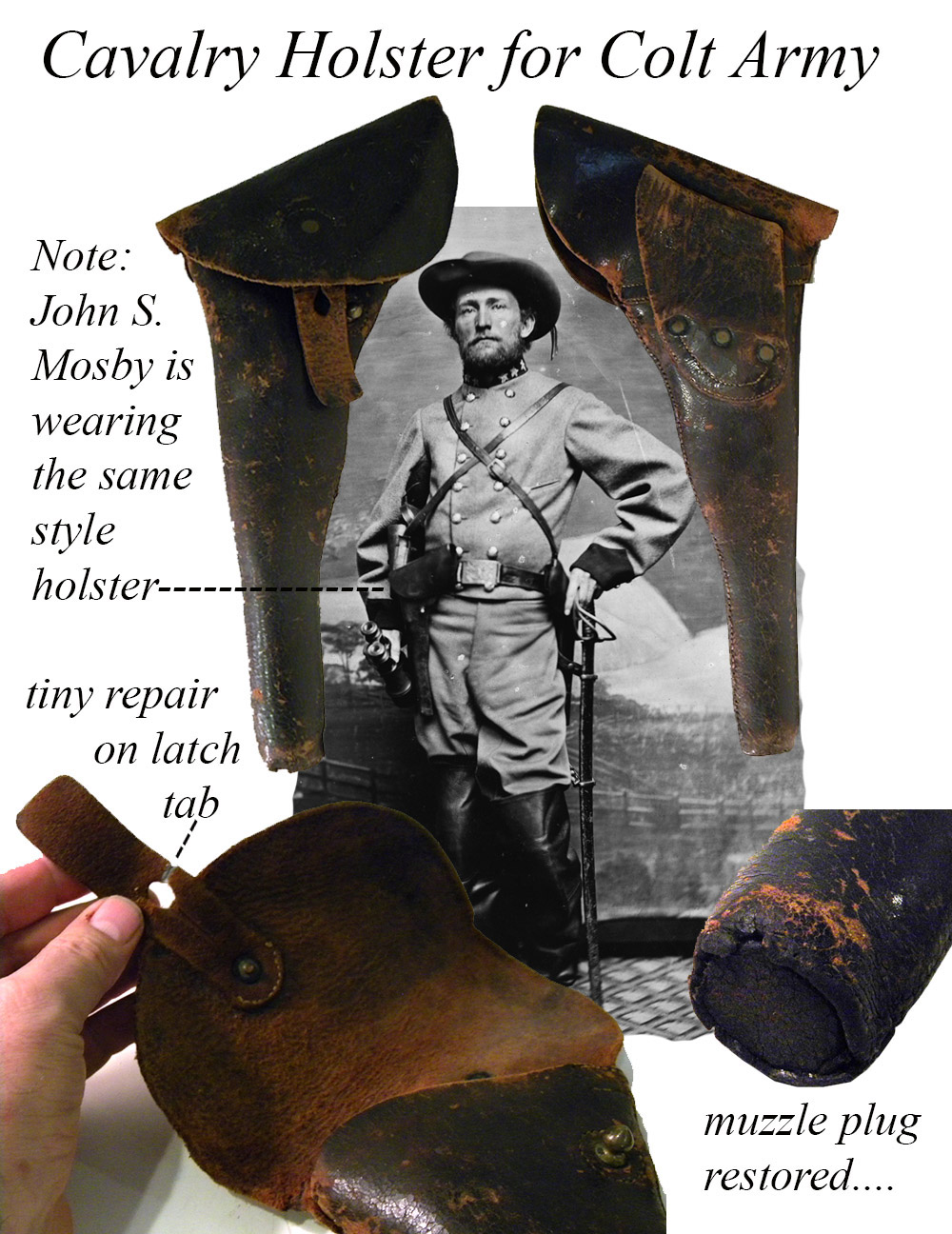
15-08-37 … Civil War Cavalry Holster For Colt or Remington Army Revolver …
Overall VG condition with good finish. Shows expected finish wear on the high spots. These holsters were issued with the Colt and Remington 44 caliber revolvers and fit either gun. They also accept Colt and Remington Navy revolvers just fine, just having a little extra room. The latch tab has a tiny repair as shown in the illustration. The end plug has been replaced… otherwise 100% original and as issued. A good solid example of the regulation issue full flap cavalry holster in the standard butt-forward configuration (butt forward when worn on the troopers right side). This design made it easier to draw when the holster was positioned,
“at the right side of the back,”
as Cooke phrases it in his 1861 cavalry tactics manual. The manual instructs … ”
At the command, (draw)… “PISTOL”, with the right hand unbutton the flap of the belt-hoister, draw the pistol, and, holding it at the stock, with the point of the forefinger reaching above the trigger guard, carry it vertically, with the hand as high as the right shoulder, and six inches in front of it.
Though, interestingly, Cooke did allow the trooper to hold the pistol with his left hand if necessary while cocking it with his right, before again bringing it to the “raise pistol” position in front of his right shoulder. We see by reading Cooke’s manual that the holsters were intended to be worn at the right hand side of the troopers back… a position too far for the left hand to reach and angled such that the right hand would require a “left hand draw” holster to facilitate the extraction of the revolver at that angle. Actual wartime photos of troopers generally show them wearing the holsters at their side, like our Mosby shown here. In that event the trooper might well have easier extracted his Colt with his left hand. One major auction house who should know better recently billed their regulation holster as an extremely rare “left handed” holster— go figure. These are getting tough to find in any sort of reasonable condition and are an iconic piece of cavalry gear
… $550.00
Click Here to E-mail Us!
Call us @ 419-842-1863
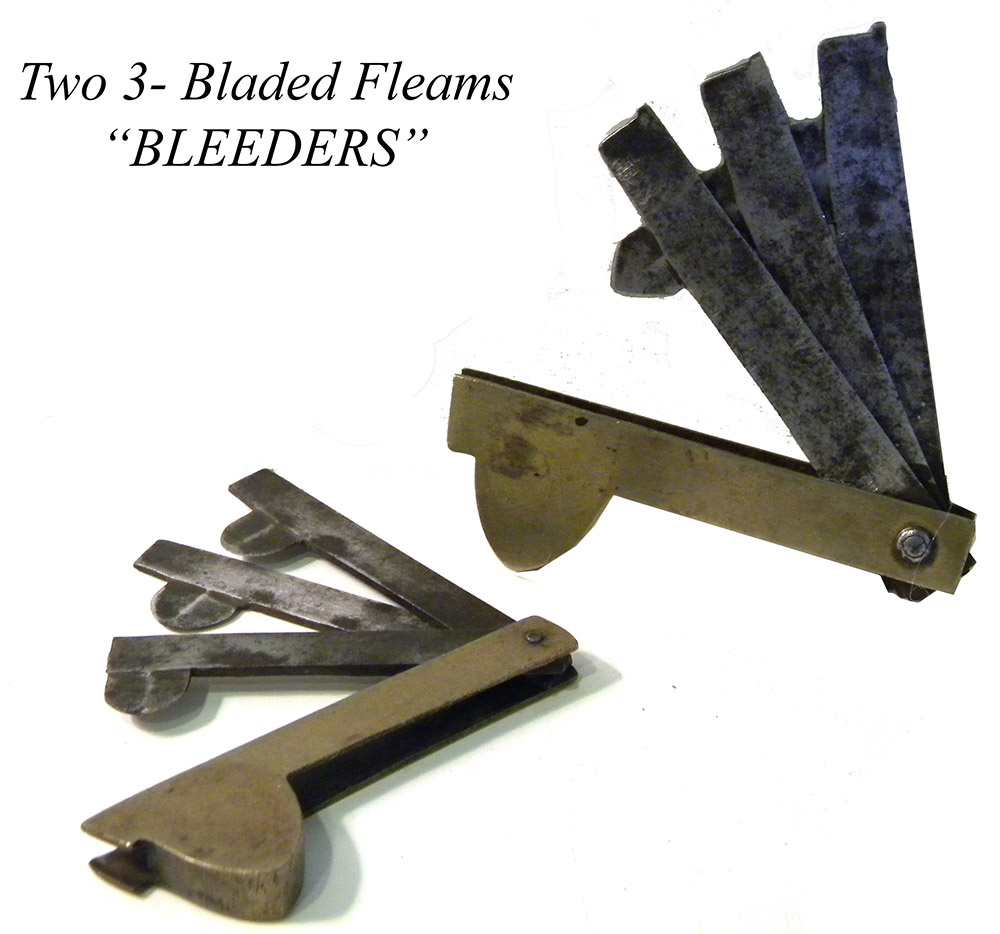
15-08-38 … Two Three-Bleaded Fleams – Bleeders …
A pair of early to mid 19th century brass handle bleeders. One measures 3.25 inches long. The other measures 3.12 inches long. VG condition. Unmarked. Great medical display items from the days when bleeding cured most of your ills. Get rid of that bad blood. The pair
… $95.00 – SOLD
Click Here to E-mail Us!
Call us @ 419-842-1863
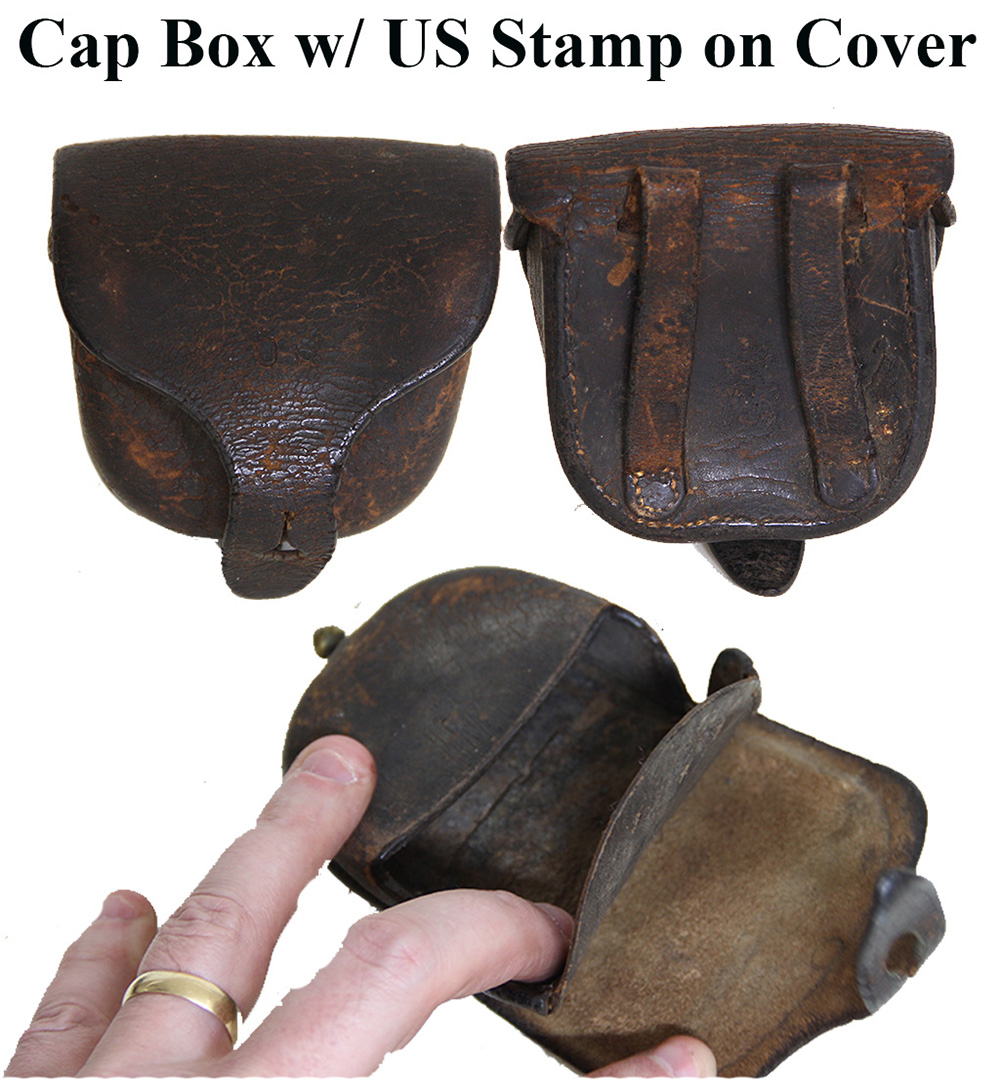
15-08-39 … Cap Box with U.S. Stamp on Cover:
Early pattern with abbreviated outer flap similar in design to the Mexican War cap boxes. This one stamped US on the outer flap. Completely sewn construction. No rivets used … hence an early war or pre war specimen. Overall VG + condition
… $145.00
Click Here to E-mail Us!
Call us @ 419-842-1863
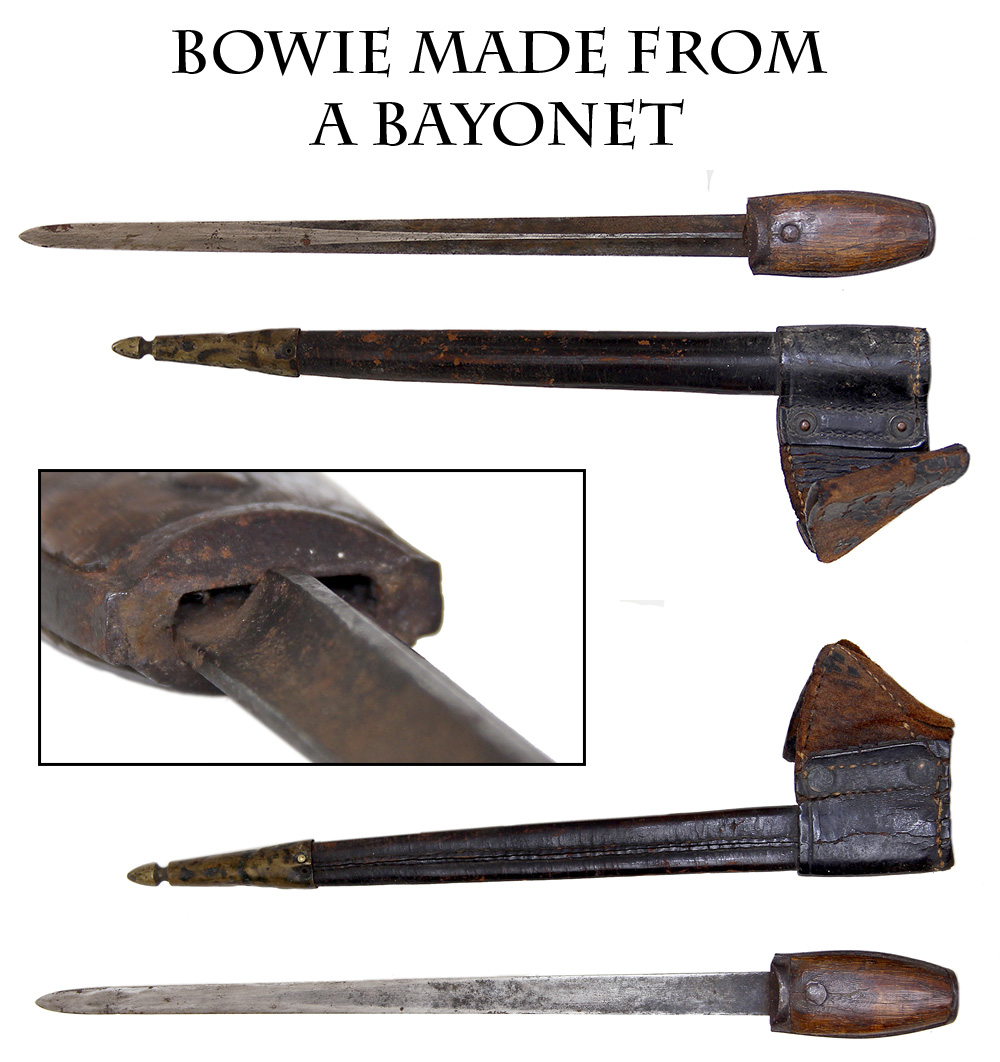
15-08-40 … Outstanding Western Frontier Knife …
About as interesting a frontier weapon as I have found. I can picture it hanging off the belt of a Western Frontiersman or Frontier Desperado or a Buffalo Skinner as he journeys through the Buffalo country in the 1870s. It is an absolutely 100% honest and genuine “stabbing knife” made from a Civil War socket bayonet and housed in the modified CW scabbard. The triangular blade is affixed to a stubby wooden handle which exhibits superb untouched wear and patina. It was unquestionably altered to this form shortly after the Civil War. The first six inches of blade retain the full angular configuration. The last few inches have been flattened down to more of a knife blade. The owner was likely a very poor man or at best extremely frugal. No fancy Sheffield blade for him — he could stab ya just as good with his home made sticker
… $450.00
Click Here to E-mail Us!
Call us @ 419-842-1863
~~~~~~~~~~~~~~~~~~~~~~~~~~~~~~~~~~~~~~~~~~~~~~~~~~~~~~~~~~~~~~~~~~~~~~
NOTE: In case you did not know this trick….
To enlarge the photos hold down the control key and press the + (plus) key a couple times. To return to the standard size hold down the control key and press the – (minus) key a couple times.
~~~~~~~~~~~~~~~~~~~~~~~~~~~~~~~~~~~~~~~~~~~~~~~~~~~~~~~~~~~~~~~~~~~~~~
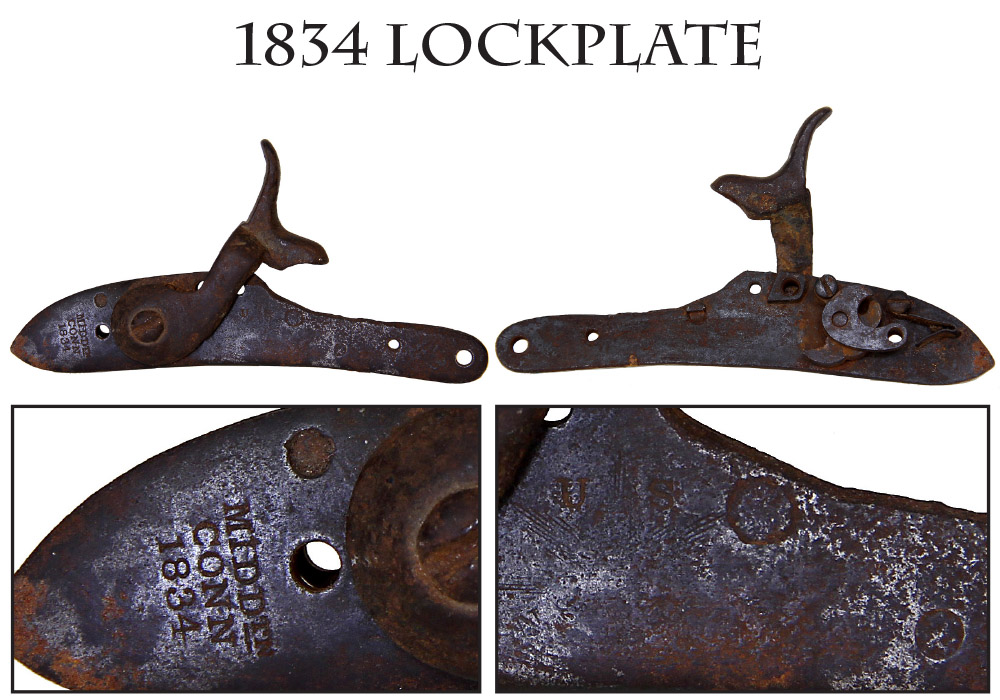
15-08-41 … Nathan Starr 1816 Contract Musket Lock Plate With A Southern Flavor …
A southern picker who sends us stuff from time to time found this at a flea market in his area. It is a lock plate from an 1816 Starr contract musket that still shows the “Middt’n/Conn/1834” date behind the hammer and the U.S. over the starburst forward of the hammer with traces of the “N. STARR” underneath. The hammer shows it to have been converted to percussion in a crude but military looking style. Someone might recognize it as the work of a particular arsenal or southern workshop. I think it’s neat no matter what. Neat southern relic … noco
… $35.00
Click Here to E-mail Us!
Call us @ 419-842-1863

15-08-42 … Presentation Inscribed Bacon Navy Model Revolver …
A very scarce gun in its own right, this one scarcer yet as it is inscribed on the back strap with the Ohio officer’s name that carried it. This is one of the last guns I bought from Uncle Norm Flayderman. It is overall VG condition. Backstrap is engraved… “Presented to Lieut. John H. Holenshade by Members of 5th Ohio Battery”. Records show he served from September 1861 through March 1862. He was definitely present at Shiloh… but not in any way that adds luster to the history. Author and friend Wiley Sword has records on the battle and called to tell me that Holenshade, though officially discharged, was present when the battle broke out. He immediately took the next boat up the river and went home. So this gun was present on the field— but didn’t kill any Johnny rebs. The unit history is … This battery was mustered into service from Aug. 31 to Sept. 20, 1861 at Cincinnati, by Capt. Wilson, to serve for three years. It was filled to a maximum of 170 men, who were forwarded to St. Louis as fast as enlisted. It was actively engaged through the en- tire first day of the battle of Shiloh and lost in this, its first battle, 1 man killed and 20 wounded, 2 pieces, 4 cais- sons, 65 horses, and all camp and garrison equipage. About the middle of September the battery marched with its division to Iuka, but was not in position to take part in the action. It was actively engaged in the battle of Corinth, but suffered no loss. During the siege of Vicksburg the battery was constantly on duty, the position it held being on a prominent hill rather in advance of the general line and the view was uninterrupted for several miles to the right. About 3,000 rounds of ammuni- tion were fired by the battery during the siege and a number of the men were wounded more or less severely but none were killed outright. In the movement that followed against Jackson the battery lost 1 killed and 8 wounded, being posted on an emi- nence from which it kept up a steady fire for some time. It then took part in the movement against Little Rock, Ark. The battery was mustered out July 31, 1865. The revolver lacks a main spring. It appears complete except for that spring. The spring can be manufactured by a competent gunsmith. A scarce pistol with nice inscription, and VERY early war history … exflayd
… $2,250.00
Click Here to E-mail Us!
Call us @ 419-842-1863

15-08-43 … US “Puppy Paw” Belt Buckle …
The brass oval US belt plate with a lead solder filled back is the quintessential Civil War belt plate with lots of variation among makers. Non-dug, these are both early “puppy paw” style plates, one of which could date back to the Mexican War. The “tell” is the round studs (as opposed to oval) that secure the buckle to the belt. Each of these has the standard contoured heavy hook to fasten the belt closed.
Early rounded studs beginning to show slight oval shape… very early Civil War production… light bends to the left and right edges, minor dings and a stain at upper center to the face. Scratched note on the back “N T 1862”. Much much rarer than arrow hook buckles, and also scarcer than the oval “puppy paw” stud buckles
… $325.00
Click Here to E-mail Us!
Call us @ 419-842-1863

15-08-44 … CDV of a Character-Filled Black Gentleman …
Sharp vignette portrait bust of black gentleman in formal dress. No back mark or identification, but this guy has the look of experience and determination. His mouth is slightly downturned, giving the impression of a long hard life, but his fixed serious expression indicates someone not to be trifled with. At the same time he has raised one eyebrow slightly, indicating to the viewer he has taken your measure and he is not terribly impressed. One very strong portrait. Slight foxing spots overall but nice tones and a crisp card … beyy
… $85.00
Click Here to E-mail Us!
Call us @ 419-842-1863
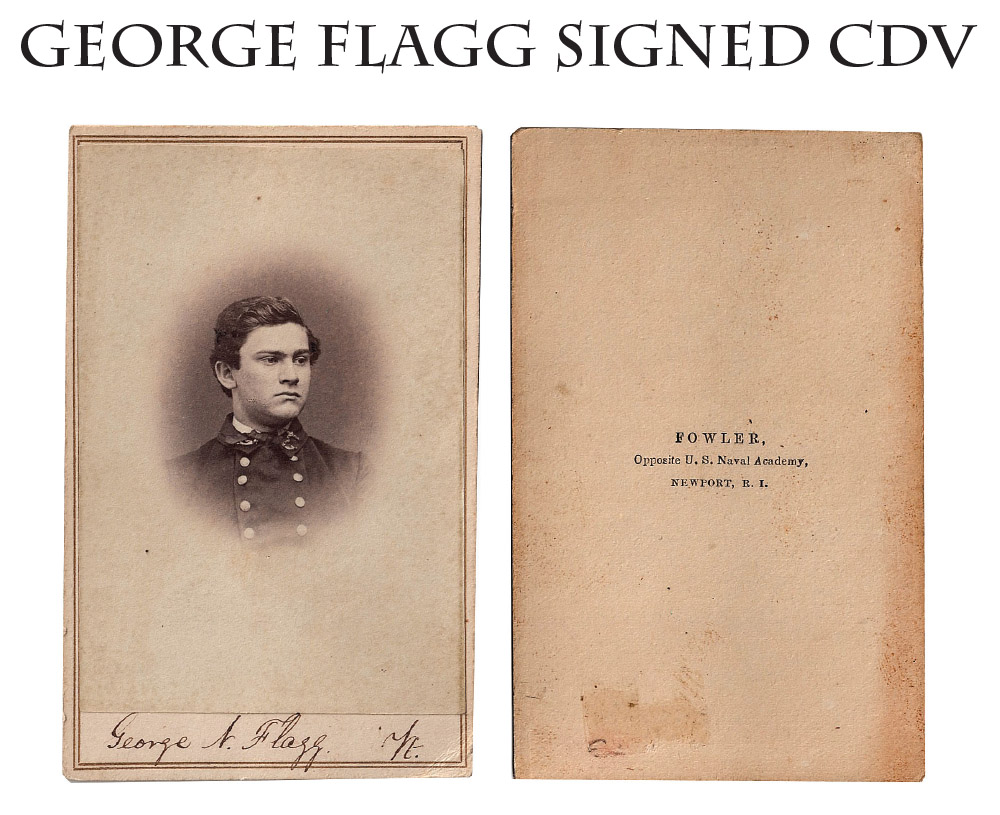
15-08-45 … U.S. Navy Officer George A. Flagg Jr. …
Nice vignette portrait bust of a USN cadet by Fowler, Newport R.I. Opposite U.S. Naval Academy. Flagg entered the US Naval Academy as a midshipman 9/21/61 and graduated 11/22/64. He made Ensign 11/21/66; Master 12/1/66; and Lieutenant 3/12/68. He died 6/20/69. A very crisp view of the young naval officer
… $65.00
Click Here to E-mail Us!
Call us @ 419-842-1863
~~~~~~~~~~~~~~~~~~~~~~~~~~~~~~~~~~~~~~~~~~~~~~~~~~~~~~~~~~~~~~~~~~~~~~
NOTE: In case you did not know this trick….
To enlarge the photos hold down the control key and press the + (plus) key a couple times. To return to the standard size hold down the control key and press the – (minus) key a couple times.
~~~~~~~~~~~~~~~~~~~~~~~~~~~~~~~~~~~~~~~~~~~~~~~~~~~~~~~~~~~~~~~~~~~~~~

15-08-46 … Special Aide to Lincoln / African American Related / Signed CDV of Colonel Le Grand Bouton Cannon, Aide-de-Camp to General Wool, influential in the Union Defense Committee in 1861,
the sheltering of escaped slaves at Fortress Monroe, the enlisting of black troops in the army, and internal army politics. Crisp vignetted bust view of a field-grade officer with flashy sideburns! Cannon was from New York and had served as a volunteer on General Wool’s staff before the Civil War. When most of Wool’s staff resigned and went south, Cannon and a few other prominent New Yorkers joined his staff as volunteers, Cannon acting a volunteer ADC to Wool from April 23 to August 28, 1861. During this period he took an active part in the Union Defense Committee of New York in corresponding with and aiding various northern governors, like the Governor of Illinois, who were trying to obtain arms, etc., and organize without adequate leadership from Washington.
Cannon was officially appointed Major and AADC on Wool’s staff August 28; and Colonel on Feb. 1, 1862. He accompanied Wool to Fortress Monroe, Virginia, which they preserved for the Union. Cannon was involved in formulating the “contraband” policy about escaped slaves who had sought protection at Fortress Monroe and was intimately involved in some of the army’s political infighting. His reminiscences published after the war include a number of first hand accounts of the Monitor and the Merrimac, time spent as a special aide to Lincoln, and experiences with Secretary Stanton, etc. Cannon resigned June 11, 1862, but rejoined Wool’s staff as a volunteer for a time thereafter, until Wool’s retirement in 1863. Cannon’s accounts are a real insider’s view of the doings at various army headquarters. He had been offered the military command of Norfolk, before resigning.
The card is presented to Lt. Col. Whipple, who is probably William Dennison Whipple, West Point class of 1847, who served until 1890, was both ADC and AAG at different points in his career, served on Gen. Hunter’s staff, the staff of General Thomas, and after the war as ADC to Sherman from 1873 to 1878: “Lt. Col. Whipple USA / Asst Adjt Genl / With regards / Le GB Cannon Col / USA & ADC.” Their staff duties had probably brought them into connection at some point, though Whipple was a New Yorker like Cannon.
A significant subject involved in some important early war doings
… $95.00
Click Here to E-mail Us!
Call us @ 419-842-1863
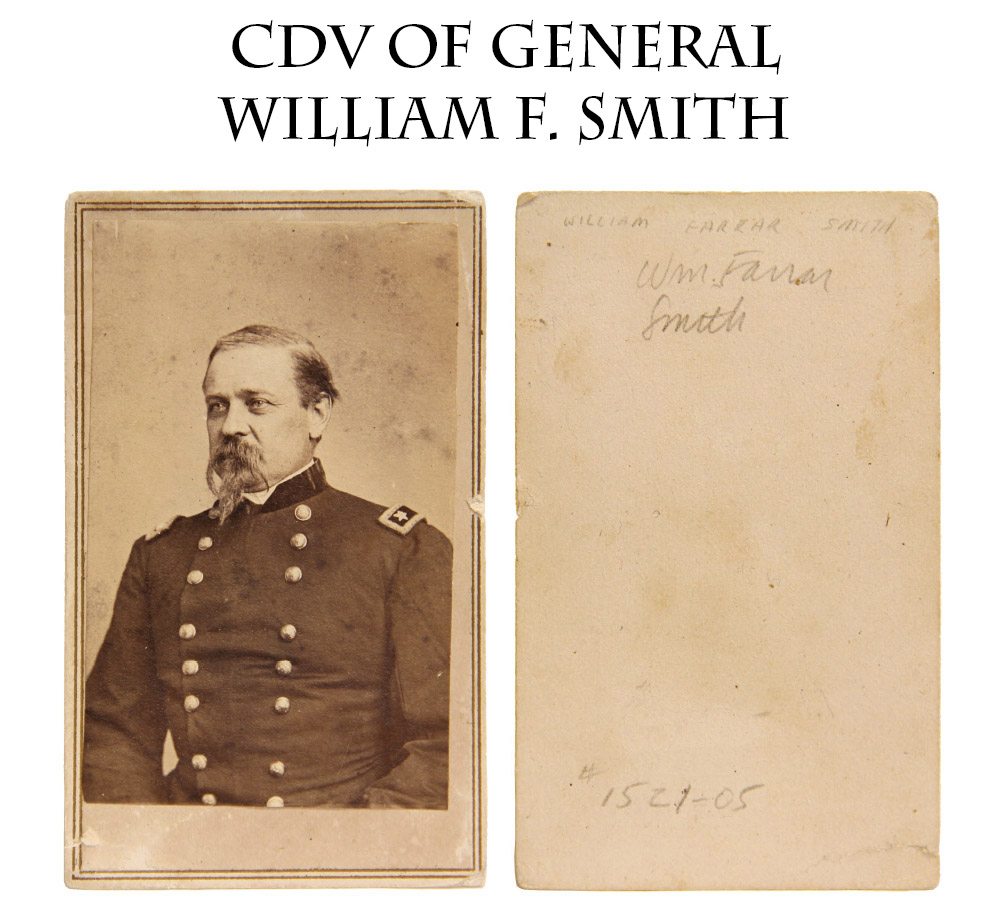
15-08-47 … General William F. Smith—He spoke his mind!
Wonderful half-length seated view of the outspoken general in his major-general’s frock coat. Couple minor abrasions to card edge, otherwise excellent. “Baldy Smith” was West Point class of 1845, an officer of engineers until the Civil War, and Colonel of the 3rd Vermont in 1861 serving on the staff of General McDowell at Bull Run. He became a Brigadier General of Volunteers in 1861 and led a division of the 6th Corps on the Peninsula and the Maryland Campaign, and commanded the corps at Fredericksburg. Critical of Burnside and a supporter of McClellan, he was shunted aside in 1863 and sent west, where he ended up feuding with Rosecrans but earning some praise from Grant, and made Major General in 1864. Brought east to command the 18th Corps under Butler, he criticized both Butler and eventually Meade. Accusations that he could have acted more aggressively at Petersburg led to his removal from command in July, 1864. He left the army in 1867, turning to civil engineering and acting as president of a telegraph company and the NY Board of Police Commissioners until his death in 1903. My favorite quote of his was his judgment on Butler: “as helpless as a child on the field of battle and as visionary as an opium eater in council.” He cerrtainly knew how to craft a criticism
… $79.00
– SOLD
Click Here to E-mail Us!
Call us @ 419-842-1863
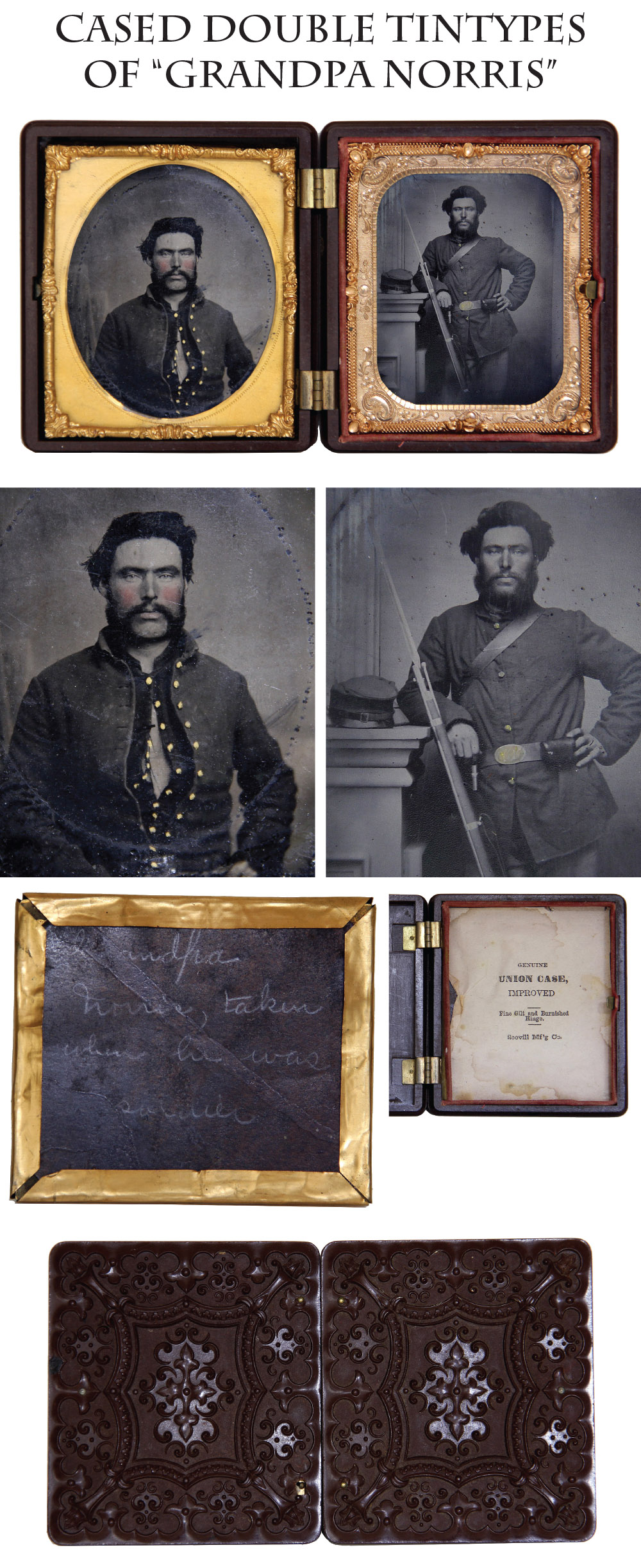
15-08-48 … Cased Pair of Sixth Plate Tintypes of Grandpa Norris, Taken When He Was A Soldier. …
Superb pair of tintypes in a fine thermoplastic double casing. The images were taken in two different sittings of what is obviously the same soldier with a family notation on the back of one. In one he appears seated waist-up in a shell-jacket that is open to expose a vest and watch chain. His buttons have been gilded and cheeks tinted, but there is good clarity and just minor mat marks on the plate. The companion view shows him looking a little shaggier, in a 4-button fatigue blouse, standing, hand on hip and leaning on a studio column, his forage cap next to, and an 1861 pattern rifle musket with its bayonet fixed leaning against the column as well. He wears a regulation infantry waist belt with oval US plate and a cap box. He has reversed his cartridge box sling, which hides the round eagle plate, but makes it appear to hang correctly on his right side to offset the reversal of the tintype process. Very good clarity and detail, wrinkles in his fatigue blouse and even what seems to be the socket of a bayonet on his belt as well, indicating he borrowed the rifle from another soldier in the studio or someone fixed another bayonet his rifle to save time. In this pose his cheeks have also been slightly tinted and a light gold wash applied to the belt plate that obscures but does not completely hide the U.S. The photos are housed in a nice thermoplastic double case with floral and geometric motifs. Frames, mats and glass in place. Scovill Union Case paper label intact in one side. There are an awful lot of Yankee infantrymen named Norris so researching that aspect would seem a needle in a haystack type of chore. But who knows. Super images in super case … g132
… $650.00 – SOLD
Click Here to E-mail Us!
Call us @ 419-842-1863
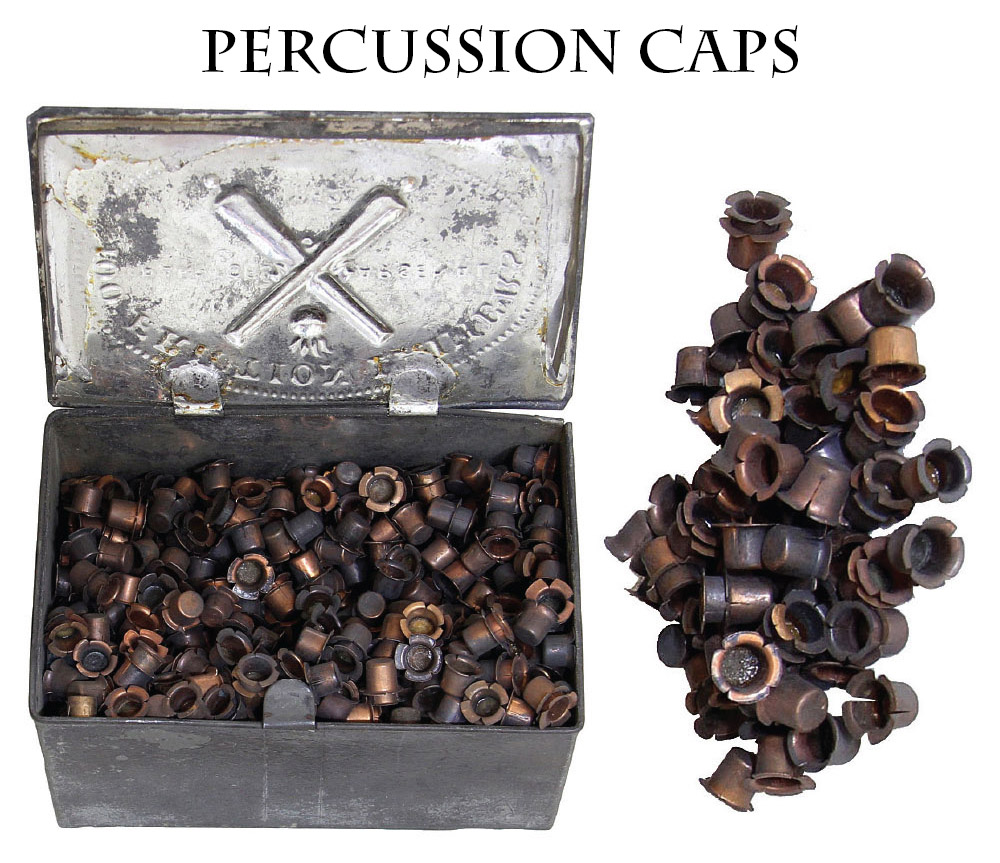
15-06-50 … Friction Primer Tin [Tin not for sale] and Percussion Caps …
I just purchased this neat old relic and am offering the percussion caps inside the tin in this offering. This very scarce tin came just as you see it, filled with percussion caps for muskets. The tin itself is the arsenal tin used to hold artillery friction primers. These are darned hard to find! I can only think of one instance where I found one still in a primer pouch! The tin has a hinged cover with small latch and embossed top reading: 100 FRICTION PRIMERS in an arc over an ordnance insignia, and FRANKFORD ARSENAL on either side. I don t know who put the percussion caps in the tin, it was certainly a handy storage idea, but since they do not belong together, I am splitting up the lot.
In each package of ten cartridges the soldier got 12 caps. While the supply lasts I will sell the percussion caps …
One Dozen … … … $15
Two Dozen … … … $25
Five dozen … … … $50
Click Here to E-mail Us!
Call us @ 419-842-1863
Layaways are Welcome
Need to split your order into multiple payments? No problem! A simple 20% earnest money deposit will hold your item for you.-acf
You can then pay it off in easy installments that fit your budget.
Read Terms Here
Items to Sell? Contact Us
I am always interested in buying ANYTHING from the American Civil War… Guns, Swords, Civil War Muskets, Knives, Uniforms, Flags, Medals, Badges, Diaries, Letters, Autographs, Buttons, photographs, tintypes, daguerreotypes, Insignia, Camp Items, Battlefield Relics, canteens, Drums, Etc… Call 419-842-1863 and ask for Dave Taylor.

